Education
- Details
- Written by: Quintus Potgieter
Is engineering suffering a lack of interest in the world today? Is science the new normal for students who desire a career in a profitable STEM industry? STEMJobs.com defines the divide between engineering and science quite nicely: "Engineering boils down to how things work...Scientists observe the world...Science creates questions, while engineering creates solutions." So, why then are students ditching engineering for science-focused subjects and even humanities subjects in India?
Students have said that the high cost of engineering courses and the inability to find jobs once qualified has discouraged potential Indian engineering students from chasing qualifications. National Colleges in India say that Geology has become a sought after the subject that fills up class attendance quickly compared to engineering subjects, as confirmed by The Times of India.
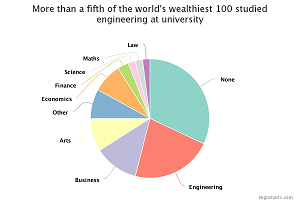
Bernard Charles, CEO of Dassault SYSTÈMES, an engineering company dedicated to science, technology, and art recently spoke at a conference saying that science and engineering work hand in hand. According to Engineering.com, he has been instrumental in trying to get his company to buy companies in the science industry. They recently bought Acelerysis for USD$750 million. So engineers are actively seeking to implement life sciences and engineering. However, should students be picking a side?
Nonetheless, Approved Index has good news for engineering students. They have picked the right career and are on their way to becoming billionaires. They have taken the data of the wealthiest 100 people and looked at what they have studied. As a result, more than a fifth of the world's 100 billionaires studies engineering. Reportedly only 4% of the group studied maths and science at a tertiary institution, however, engineering does involve a deep understanding of mathematics.
London Economics also conducted a study that saw staggering results in how much money a female graduate can make in a STEM field. The results showed that a female who takes at least one STEM A-level subject could see their wages grow by USD$6509.4. The study conducted with the assistance of 13,000 respondents showed that females who did well in maths at school make 25 percent more money than other students who did poorly, in jobs later on in life.
It seems engineering wins at the end of the day but being directly involved in a STEM career would be profitable to start with. Elon Musk says an engineer will win in the argument between science and engineering:
- Details
- Written by: Quintus Potgieter
The first carmaker to jump onto the Internet of Things industrial revolution bandwagon has announced a new network it plans to connect all its vehicles to. Toyota in collaboration with Japanese telecommunications company, KDDI Corp., will be connecting vehicles to the cloud. The companies want to design a "uniform data communication module" that can be used to connect cars globally and will be installed in cars in Japan and the United States by 2020. The automaker has expressed a desire to move the technology into global markets after they meet their goals in Japan and the US.
Toyota and KDDI hope to make the technology available to other companies that might be able to connect their vehicles and products to the unified network. KDDI reportedly has ties with 600 other telecommunications companies who will also utilize the network.
The communication network will use country-specific carriers to host the network
Shigeki Tomoyama, a senior officer at Toyota, said: "Communications technology is essential to enhance vehicle connectivity and Toyota has been making efforts in this field for years. The joint establishment of this global communications platform with KDDI will help us offer a more stable and higher quality connectivity service to customers all over the world."
Toyota could send alerts and data to their cloud-connected vehicles so traffic jams or accidents could be reported and avoided by motorists. Along with that, the data the car produces through its sensors would also be uploaded to the cloud and a driver might be able to peruse the data of how well their car is performing. The possibilities are endless, and more car brands - namely Volvo - are working on networks to connect their cars to.
Another networking endeavour Toyota has been working with is the Land Cruiser Emergency Network. Toyota says they sell more Land Cruisers in Australia than any other place in the world and a lot of these vehicles are driving in the network-less Australian Outback. The Land Cruisers can now be connected together with a device that can create an emergency mobile hotspot. So if someone is in distress they can send a distress signal out and the Land Cruisers can pick it up. Then the Land Cruisers can bounce the signal off of each hotspot until it reaches an emergency service that can assist with rescue efforts. Check the video below to see how the technology was engineered:
- Details
- Written by: Quintus Potgieter
Hey budding engineer! Want to work for Total, Chevron, BP and even OPEC? Become a petroleum engineer. However, the oil world is a tough business to get into right now. Should you even get involved during the oil slow-down that is happening due to the push for renewable energies?
OPEC is currently holding talks to debate the oil crisis looming over the world as oil prices continue to plummet. A French analyst, Abhishek Deshpande talking to the Wall Street Journal said: "If oil prices go back to $100, then demand goes down the drain. OPEC should be worried." OPEC now has an oversupply of oil and doesn't know what do with it, with petroleum engineers still making their money (having to engineer the output limits of oil) but the oil in question not being sold. OPEC is seeing a lack of investment into the industry on unprecedented levels.
Uptal Gosh, CEO and president of the University of Petroleum and Energy Studies would encourage students to strive to be petroleum engineers.
 "To be a petroleum engineer you need to have knowledge of disciplines like computer science, instrumentation and control and safety, health and environment management among others. Petroleum engineers, especially those working in the upstream sector, need to be as sensitive towards the environment would be. In your quest to find oil, you should not harm the environment," said Gosh, speaking to the Hindustan Times.
"To be a petroleum engineer you need to have knowledge of disciplines like computer science, instrumentation and control and safety, health and environment management among others. Petroleum engineers, especially those working in the upstream sector, need to be as sensitive towards the environment would be. In your quest to find oil, you should not harm the environment," said Gosh, speaking to the Hindustan Times.
Payscale says a petroleum engineer can make up to $98 an hour. Interested yet? IF you do happen to be interested, then so are many other graduates who are queueing up to get into an industry that is seeing job cuts due to the crisis. The Society of Petroleum Engineers in the United States reported that in 2014, 95% of graduates with their bachelor's in petroleum engineering found work. The following year (2015) only 64% of graduates found work. What will the results be in 2016? Time will tell. Is it a good time to get into petroleum engineering?
- Details
- Written by: Quintus Potgieter
In just seven days you can make a man, all you have to do is ask Tim Curry. However, how long would it take to make a self-driving car? Engineering students from the Waterford Institue of Technology (WIT), Ireland, have the answer. Twelve weeks. The engineers utilized the university's Applied Robotics Lab and as a result, got a Toyota Corolla to drive itself down a street on campus.
Jason Berry, a lecturer at the university said: "One of the coolest sounds we ever heard on a project was listening to the car increasing revs as it gets ready to go. The project is the bread and butter of what any engineer is all about - figuring stuff out for yourself."The students are currently doing their BEng qualifications in Electronic Engineering which will take a year whilst doing their two-year higher certificate courses in Electronic Engineering.
How the engineers did it:
- Developed a console that accelerates the car through a command that tells the engine the accelerator has been pressed down
- Utilizing the same technology, they developed commands that instructed the car's engine management system to turn
- The car saw where it was going thanks to a webcam
- A servo motor that pushed the brake when it knew it needed to stop
So, lecturers and mentors of engineering, are you ready to build self-driving cars with your students? Only a twelve week process. What you're left with is a rewarding feeling of having actually engineered something.
Source: RTE
- Details
- Written by: Quintus Potgieter
Engineers are seeing the business opportunities with the rise of the Internet of Things. The booming industry presents a chance for new companies to be created, new inventions and innovations to be brought to the world and for more efficient machines to be built. A former engineer from Google has even started his own internet-of-things startup company named Afero .
Joe Britt, the former Google engineer and founder and CEO of Afero, said, "Everybody who wanted to build a connected device had to reinvent multiple wheels. You have to decide what kind of hardware to use, what kind of operating system - if any - you're going to run on the device, how you communicate with the cloud, how you interact with a mobile app. You need a connected device engineer, you need cloud developers, and all those people have to coordinate your actions to make that device work." They have created a module that will interconnect machines to the Internet of Things and sync these processes across every platform imaginable.
They have four subcategories that define their idea of the Internet of Things:
- End-to-end security
- Complete scalability
- Valuable analytics
- Rapid deployment
As is apparent, the Internet of Things has given engineers and entrepreneurs and engineer entrepreneurs the inspiration to utilize the Internet of Things and produce something.
But what are the threats to the Internet of Things?

"At the moment, we are in 2016. At the moment, there are 25 billion devices connected. By 2020, there will be 50 billion devices connected. That will make a big difference whether you're in the renewable energy area, transport, energy production, homes, entertainment. It will make a big impact on gathering data. We will need someone to process this data and that's where engineers come in," Mackay added.
He also highlighted four key areas to focus on when building a relationship with the Internet of Things and how it can boost your engineering and technology career:
- People: Hopefully serving someone: Like Afero is doing, for example. They have built something that utilizes the Internet of Things.
- Process: What you want to do with that information. Millions of data points streaming in, you need processors to decide what to do.
- Data: The analytics that has been created that can be made available to the engineers and the consumers.
- Things: Where you gather information from and where you send it to
Mackay implies that all of these things will be important in the future of the Internet of Things because the world is going forward with building smart cities and connected cars. Security is a big deal but there are also countless opportunities to capitalize on the Internet of Things and jumpstart businesses, companies and corporations.
- Details
- Written by: Quintus Potgieter
Renewable power is making strides in Europe. Britain is said to be the dark horse of the energy storage game right now, Germany ran on full renewable energy for a few hours and Portugal did a four-day stint on completely renewable energy. However, academics are poking holes in some of the plans that these governments might have as they move their countries to renewable energy. Researchers from the University of East Anglia in Norwich say that government subsidies need to be used to encourage investment in energy storage.
 The pioneering study was conducted by Dr. Dimitris Zafirakis and Dr. Konstantinos have said that they don't think the market will be ready for the amount of storage that is going to be needed, due to the "volatility" of the market. More people joining the movement, more storage needed.
The pioneering study was conducted by Dr. Dimitris Zafirakis and Dr. Konstantinos have said that they don't think the market will be ready for the amount of storage that is going to be needed, due to the "volatility" of the market. More people joining the movement, more storage needed.
"We need sufficient storage and more investment in storage systems in order for renewable energy to reach its full potential. Subsidies would encourage investment, which in turn would enable further integration of renewables into the energy sector. The fact that for some days countries such as Germany and Portugal are running their entire electricity network exclusively on renewable energy shows how far we have come to rely on it as a power source and this will continue to increase," the researchers wrote in the report.
Building the correct infrastructure behind energy storage so that it thrives is what the researchers are hoping they can achieve by the publishing of their study. Making it profitable are also the concerns of the two researchers who concern themselves with business. However, engineers both have the chance to capitalize on energy storage by either working with the companies that work on energy storage, or become installers that can assist with speeding up the process of grid-balancing.
The Electric Power Research Insitute (EPRI) in the United States also realizes that more governmental assistance is needed in the solar industry so that the entire energy storage industry is interconnected and works together toward renewable power goals. In their report, they wrote:
"The smart grid will assure the consumers are provided with reliable, high-quality digital-grade power, increased electricity-related services and an improved environment. The smart grid will allow the benefits resulting from the rapid growth of renewable power generation and storage as well as the increased use of electric vehicles to become available to consumers. Without the development of the smart grid, the full value of a lot of individual technologies like electric vehicles, electric energy storage, demand response, distributed resources, and large central station renewables such as wind and solar will not be fully realized."
- Details
- Written by: Quintus Potgieter
There is an oil field in Qatar that is considered the largest offshore field in the world and it needs a new operator. It is called the Al Shaheen field and the bids have been flying in from the usual suspects, BP, Shell, Maersk Oil (who ran the field for 25 years), Total and a whole bunch of others. The oil field is 50 miles long and produces 300,000 barrels per day, according to Reuters. Most of the companies denied to comment on their bids, but whoever is successful in their bid will be in charge of upping the BPD (barrels per day) to 500,000. A lot of companies who are trying to convince the world that they are committed to cutting carbon emissions are bidding billions for the Qatari oil field, making analysts scratch their heads.
 Chevron also got involved in the bidding, unsurprisingly, due to their shareholders who said they would not be slowing down on bids for oil. The entity that decides who wins, however, is Qatar Petroleum.
Chevron also got involved in the bidding, unsurprisingly, due to their shareholders who said they would not be slowing down on bids for oil. The entity that decides who wins, however, is Qatar Petroleum.
Robin Mills, chief executive officer of consultants Qamar Energy, said: "Big assets like this in the Middle East only come on the block quite rarely. Qatar is looking for enhanced oil recovery experience, and applying that economically at the moment would be challenging. It will take a good operator to be able to do that." Petroleum engineers, there might be some jobs in the industry opening up for you.
Allegedly, if Maersk's contract does not get renewed through this bidding war, it could be a major blow to the company who has been controlling the oilfield for quite some time now.
It is a well-known fact that Qatar has become the leader in producing liquefied natural gas and oil in the last 30 years. The oil minister for the country also has his seat as President of OPEC. The sale of the oil will be a big benefit to the company that gets it, however, with more pressure to cut down on fossil fuels, it could be a burden to them in the distant future.
- Details
- Written by: Quintus Potgieter
MIT seeks to innovate again. This time, researchers are attempting to make electronics out of coal. The only way this would be possible is if the coal was repurposed from what we use it for today to thin coal films. The researchers say they've developed four thin films of coal: anthracite, lignite, and two bituminous types. They have used the repurposed coal to make electrical heating devices that the researchers say can defrost "car windows or airplane wings". They say it could even be a biomedical implant. What is this world coming to?
The researchers in question are Jeffrey Grossman, Brent Keller, and Nicola Ferralis. They published their repurposing of coal findings in the NanoLetters journal under the title, Rethinking Coal: Thin Films of Solution-Processed Natural Carbon Nanoparticles for Electronic Devices.
Grossman works in the Department of Materials Science and Engineering (DMSE) at Morton and Clair Goulder and Family. He says: "When you look at coal as a material, and not just as something to burn, the chemistry is extremely rich." This would mean that coal is far more than just a fuel source for the world.
The electronic properties of coal have never really factored into engineering until now. The researchers are showing that coal does not need to be taken down to the atomic level to be applicable to the chemical world of engineering. In MIT's labs, all they did was grind the coal down and alter the temperatures until they got the results they desired. The researchers explained the process of using the coal films in the abstract to their journal:
Here we show a flexible solution-based method of preparing thin films with tunable electrical properties from suspension of ball-milled coals following certifugation. The as-prepared films retain the rich carbon chemistry of the starting coals with conductivities ranging over orders of magnitude, and thermal treatment of the resulting films further tunes the electrical conductivity in excess of 7 orders of magnitude.
The researchers say that the hopping energies that they observed were close to that of amorphous carbon materials and "reduced graphene oxide." This means that these coal films could have many applications. The researchers think the coal films could assist solar panels, batteries, and other electronic devices.
"This is a significant step - probably the first - to utilize nanocarbon materials, directly from unrefined coal, with controllable electronic properties and excellent stability and scalability," said Shenqiang Ren, an associate professor of mechanical engineering at Temple University, who was not part of the team but was very impressed by their efforts.
- Details
- Written by: Quintus Potgieter
Universities in the United States are going to great lengths to prove that their engineering courses are female-friendly. The University of Wyoming recently held an event called Women in STEM, that saw 500 young women from grades 7 to 12 interact with fields that in recent history have been overrun by men. The event is one of many events that have been held across the United States to attempt to further convince young women that a career in a STEM field would be beneficial to their futures.
"Women are still under-represented in the science and engineering fields, and we want to give young women information about career opportunities and college majors in these fields and expose them to all the opportunities out there in terms of science and engineering," said Shawna Mcbride, an associate director of the Wyoming NASA Space Grant Consortium, speaking to Wyoming Business Report.
Notably, professors of electrical and computer engineering held workshops for the girls, showing off robotics and Raspberry Pis, things that would hopefully pique their interest.
The University of California has also tried to bring young adult women into engineering by hosting a week-long summer camp called The UC Berkeley Girls in Engineering Week that explored the different kinds of engineering that exist in the world. The girls seemed to enjoy the biomedical engineering workshop, the robotics displays, civil engineering workshops and the software development workshops. All of the instructors at the event were women, which inspired confidence in the girls seeing as though they could see that some women do thrive in the engineering industry.
Shocking statistics
An Ohio State University study has investigated how much females who have obtained P.h.Ds earn one year after graduation. The results showed that women earn 31 percent less. The results were published in Science Daily under the title Young women in STEM fields earn up to one-third less than men.
Bruce Weinberg, co-author of the study and professor economics at Ohio State said: "There's a dramatic difference in how much early career men and women in the sciences are paid. We can't get a sense of some of the reasons behind the pay gap, but our study can't speak to whether or any of the gap is due to discrimination. Our results do suggest some lack of family-friendliness for women in these careers."
The data has confused the authors due to inconceivable reasons as to why women are earning less than men in STEM fields. The data was compiled by the U.S. Census Bureau with help from the American Institutes for Research. It is concrete evidence that women are earning less in STEM fields. The STEM career compensation data has been recently unavailable however 150 institutions will hopefully be publishing their data soon. Only 16 universities have provided data for researchers to comb over that have produced the above-mentioned results.
- Details
- Written by: Quintus Potgieter
The University of California, Davis and Santa Cruz branches, have accepted a twelve-year-old student who already has three degrees behind his name. He might be enrolling for biomedical engineering but doesn't know which university he wants to attend. What he does know is that he has aspirations to become a doctor and medical researcher when he finishes his studies at the ripe age of eighteen-years-old. His name is Tanishq Abraham
"I think I'll be 18 when I get my MD," Tanishq told reporters.
It was earlier this year that a girl of 15 aimed for a bright career in engineering in South Africa. Tapiwa Shendelane was accepted into the Univeristy of Witswatersrand for her Bachelor of Science in Industrial Engineering after achieving six distinctions in her final year at school.
"I used to get 100% in tests all the time without even putting in an effort. Even in my matric year, I didn't expect to do as well as I did, because I did not put in an effort," she said to News 24. "Age means nothing to me. I believe that education creates success and I want to encourage every young person to work hard despite their circumstances."
You might be thinking: Twelve years old, fifteen years old, that is far too young for a child to have left school and start studying. However, they get even younger than that. Before the end of last year, the Independent reported a story about a boy named Ayan Qureshi who became the youngest qualified Microsoft Computer Specialist. He was five years old when he completed the exam at Birmingham University. The qualification includes a deep understanding of Microsoft operating systems and how they can be turned into networks and the technology behind them.
These children are on their way to becoming superstar engineers because they have the mind for it and the resilience to continue working towards careers in the industry. Most children get disinterested in engineering at a young age in what the Dean of the Engineering Institute of Technology calls the engineering valley of death. To ensure the disinterest of STEM subjects don't happen, nonprofit groups in the U.S. have started up. A group called 100Kin10 was founded back in 2011 and, according to Fortune, has trained 28,000 STEM teachers that will attempt to inspire students to continue pursuing their STEM career dreams.
The stories of children who are persevering through engineering at a young age are so rare and isolated that we almost never hear of them but when we do it makes us wonder about how we could keep children interested in STEM subjects and get them to have fruitful engineering careers in the future. One benefit for children would be having a parent who is already an engineer who show them how it is done and bring them up in an engineering household. However, children should dictate their own destinies but as is apparent, some kids decide from a young age that engineering excites them and they go on to achieve some amazing things.
- Details
- Written by: Quintus Potgieter
Getting your honours degree in chemical engineering should lead to employment regardless of the country you got in, right? In South Africa, chemical engineers are taking to the streets to physically beg for jobs in the industry. Social media has sparked a conversation about graduates not being able to get jobs after two photos purportedly showing graduates begging for jobs found their way onto Facebook and Twitter this week.
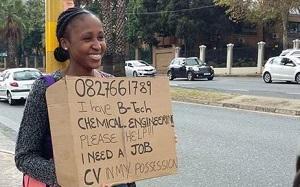 Both pictures show citizens of the country that claim to have B-tech degrees in chemical engineering. In the first photo that emerged a woman wrote, "I have B-Tech Chemical Engineering. Please help!!! I NEED A JOB. CV in my possession," on a piece of cardboard and stood at traffic lights which is an action synonymous with beggars in the country. Her name is Anthea Malwandle and stood at an intersection in Rosebank, Johannesburg. According to EWN, she completed her degree at the Vaal University of Technology in 2015 and has been looking for a job ever since. The silver lining is that after the picture was shared on social media, she finally got an interview at Sasol.
Both pictures show citizens of the country that claim to have B-tech degrees in chemical engineering. In the first photo that emerged a woman wrote, "I have B-Tech Chemical Engineering. Please help!!! I NEED A JOB. CV in my possession," on a piece of cardboard and stood at traffic lights which is an action synonymous with beggars in the country. Her name is Anthea Malwandle and stood at an intersection in Rosebank, Johannesburg. According to EWN, she completed her degree at the Vaal University of Technology in 2015 and has been looking for a job ever since. The silver lining is that after the picture was shared on social media, she finally got an interview at Sasol.
Then another picture emerged onto social media of a man named Sello Mokate, who graduated from the University of the Free State with his B-tech in chemical engineering as well. He too took to the streets with a cardboard stating his qualifications and asking for a job.
Mokate spoke to Times Live, saying: "It pains me that I rely on my older brother and parents for provisions but I have a B-tech. I thought I would be employed by now but I have sent countless emails and I went to a number of interviews with no success."
Where the divide is occurring is due to the fact that a BSc (Bachelor of Science) or B.Eng (Bachelor in Engineering) degree is research and development oriented and seemingly highly regarded, whilst a Btech degree is implementation oriented. Nonetheless, both 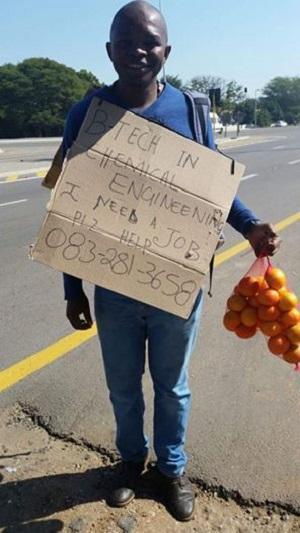 should equate to a job in the industry, however, BTech degrees seem to be ignored by employers. This could be due to the fact that BSc and B. Eng degrees sometimes come from highly regarded universities compared to some BTech students who get their degrees - starting with a national diploma - through a technikon or technical college.
should equate to a job in the industry, however, BTech degrees seem to be ignored by employers. This could be due to the fact that BSc and B. Eng degrees sometimes come from highly regarded universities compared to some BTech students who get their degrees - starting with a national diploma - through a technikon or technical college.
The country has tried to level the playing field and make the qualifications made at technikons equal to those of universities but as is apparent due to the social media postings, that has not been the case. As a result, you get a gap between engineering graduates and employers that seem to exercise preference. However, the situation is changing in a country which is desperately looking for engineers in certain fields. Qualifications from all sorts of institutions are slowly but surely becoming more relevant to employers who require engineers in the industry.
- Details
- Written by: Quintus Potgieter
The World Health Organisation has said that 360 million people in the world are suffering with some sort of hearing loss. The most affected areas are South Asia, Asia Pacific and parts of Africa. Medical experts say that hearing loss is avoidable if diagnosed early on through primary prevention. However, the areas aforementioned are third-world areas and don't always have access to primary prevention processes in avoiding hearing loss.
Thankfully, engineering students are coming to the rescue and proposing a cheaper alternative to octoscopes that would involve plugging an item into a smartphone then taking photos of inside the ear. Students at Texas A&M University in the Engineering World Health department designed a model LED otoscope that will hopefully recieve funding so that anyone can keep a tab on the health of their ears.
This is not a foreign idea, there is a product called the Cellscope Oto that serves a similar purpose. With more and more engineers working on this technology, we could see the tool distributed globally for the health of ears everywhere.
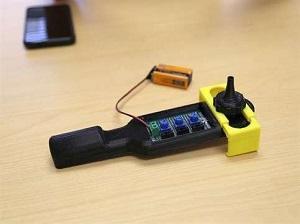
Tessa Bronez, a biomedical engineering graduate, said: "We have a lot of electrical engineers on the team, and they were really excited about doing something with optics."
The engineers decided to use a cell phone to make the otoscope cheaper due to the camera on the phone being instrumental in the process. "A lot of people are surprised to hear that many people in developing countries have smartphones, particularly in the more urban areas where hospitals are," Bonez said.
The team of engineers used a 3D printer, a normal otoscope lens and a motherboard. Then the smartphone can be attached to the device and be ready to monitor ear health. The researchers say the cost is $6.42. This is far cheaper than the estimated price of $299 for the otoscope by Cellscope, that will sell an iPhone case with the attachment on it. The low price point makes the students at Texas A&M University's otoscope design the most economical one that would apply directly to impoverished communities.
Source: Medical Xpress
- Details
- Written by: Quintus Potgieter
The National Assessment of Educational Progress (NAEP) has released its very first report card that measures technology and engineering literacy in schools in the United States. Published in the report named The Nation's Report Card: Technology and Engineering Literacy, the researchers observed how literate teenagers in the eight grade were by supplying "scenario-based tasks" on computers to measure their understanding of the subjects.
The results were:
- 45 percent of girls were above the proficiency level
- 42 percent of boys were above the proficiency level
- 43 percent of students were above the proficiency level
The results show that female students are in prime positions to further pursue studies that could lead to fruitful engineering careers due to the proficiency level being slightly higher than boys. The report observed 21,500 students from 800 public and private schools since 2014.
 "This assessment requires students to examine evidence, ask and answer challenging questions and choose the right tools for the problem at hand. This is the exact kind of thinking that the modern world demands at home and in the workplace, no matter the career path," said Chair of the National Assessment Governing Board, Terry Mazany.
"This assessment requires students to examine evidence, ask and answer challenging questions and choose the right tools for the problem at hand. This is the exact kind of thinking that the modern world demands at home and in the workplace, no matter the career path," said Chair of the National Assessment Governing Board, Terry Mazany.
63 percent of students said that they gained their engineering and technology literacy from family members, whereas 19 percent of students said to have taught themselves their proficiency.
"The scores clearly show that when students have opportunities to engage with technology and engineering, they become fluent in skills that prepare them for living and working in the modern world. But access to these opportunities from place to place is patchy. That's a call for communities to create opportunities where needed from schools to science centers to after-school programming," said Dr. Tonya Matthews, President, and CEO of the Michigan Science Center.
- Details
- Written by: Quintus Potgieter
Additive manufacturing is one of the modern marvels of the engineering world and it could become even more useful thanks to laser technology. A 3D printer built at Harvard University's Wyss Insitute and Harvard SEAS can create metallic objects in midair. The printer operates through what is called 'direct ink writing' that releases metallic inks, which is instantly frozen in place by a laser. The nanoparticle inks are squirted out of a nozzle in the printer's manufacturing and the laser solidifies it into predetermined structures.
"This sophisticated use of laser technology to enhance 3D printing capabilities not only inspires new kinds of products, it moves the frontier of solid free-form fabrication into an exciting new realm, demonstrating once again that previously accepted design limitations can be overcome by innovation," Wyss Insitute Director Donald Ingber, told Engadget.
According to the researchers' video, the wires that are printed through the solidifying of the nanoparticle ink are thinner than the width of a hair and are complex metallic structures the minute it makes contact with the laser. The researchers think this breakthrough in additive manufacturing could create new opportunities in electronic devices, sensors and more.
However, it wasn't all smooth sailing in crafting such a 3D printer:
Mark Skylar-Scott, one of the head researchers on the project said: "If the laser gets too close to the nozzle during printing, heat is conducted upstream, which clogs the nozzle with solidified ink. To address, this we devised a heat transfer model to account for temperature distribution along a given silver-wire pattern, allowing us to modulate the printing speed and distance between the nozzle and laser to elegantly control the laser annealing process 'on the fly'".
The researchers published their findings in the Proceedings of the National Academy of Sciences of the United States of America under the title Laser-assisted direct ink writing of planar and 3D metal architectures.
- Details
- Written by: Quintus Potgieter
The Royal Academy of Engineering in the United Kingdom has announced its shortlist for an award they have been awarding to engineering firms annually since 1969. The MacRobert Award gives £50,000 to an engineering firm to celebrate the products the firms are producing in the United Kingdom. The award highlights the cutting edge technology that is currently the most notable in the engineering world in the UK specifically. The three finalists for 2016 have been released. The shortlisted finalists are:
Jaguar Land Rover:
- In 2011, they pledged to invest £1.5 billion into product development for a five year period
- They have designed the new 'Ingenium' engine that promises less fuel consumption and emission reduction that are found in their new cars
Siemens Magnet Technology:
- Developed 7 Tesla (7T) magnet for research and clinical (medical) applications. The magnet will join their preexisting range and will be called the MAGNETOM Terra
- Their product would double the strength of MRI scanners, ensuring much higher quality scans
- They are expecting FDA approval. The machine could lead to earlier diagnoses for conditions like Alzheimer's and Parkinson's et al.
To see how a 7T MRI works and why it is a good addition to the medical research field, look at the video below:
The last finalist is a company called 'Blatchford' that has produced a prosthetic limb with robotic control that simulates the movements of a normal leg.

They have created the 'Linx' prosthetic limb that is used with the software the company has developed which generates data based on how a patient walks on it and can export that data via Bluetooth.
A judge for the MacRobert Award competition, Dr. Frances Saunders, said: "Blatchford has achieved a huge leap forward in making the knee and ankle joints work together as an integrated system, enabling it to adapt immediately to both the actions of the wearer and changes in the environment."
- Details
- Written by: Quintus Potgieter
It has been reiterated and reiterated by experts in the field this year, that engineers should be furthering themselves with non-engineering skills that they could use in their engineering job. The emphasis on entrepreneurship in engineering has pushed engineers to try and achieve more than just mastering their studies but also finding the business opportunity in the industries they fall into. MIT has been championing these sorts of engineering add-ons and now they have announced that they will be hosting a course named Entrepreneurial Negotiations: The MIT Way.
Bhaskar Pant, the executive director of MIT Professional Education, said: "Negotiations in the entrepreneurial arena are critical, but incredibly complex. We are fortunate to be able to offer a course on the subject from a world-renowned authority at MIT."
 The professor who lead the course, that costs a mere $475 for six weeks, Professor Lawrence Susskind, said: "Many engineers can dream up promising inventions; they can even produce a business plan and find interested investors. What they don't know how to do, though, is negotiate on their own behalf. By taking the course, engineers will gain skills and strategies they need to get buy-in, sell their ideas, and achieve success." She says that 'engineering logic' without any negotiation training can lead to serious negotiation mistakes. "The exercises we use cover new ventures in biomedicine, aerospace, and real estate. Some of MIT's own entrepreneurs who have launched successful businesses will also provide their insights on their most difficult negotiation challenges."
The professor who lead the course, that costs a mere $475 for six weeks, Professor Lawrence Susskind, said: "Many engineers can dream up promising inventions; they can even produce a business plan and find interested investors. What they don't know how to do, though, is negotiate on their own behalf. By taking the course, engineers will gain skills and strategies they need to get buy-in, sell their ideas, and achieve success." She says that 'engineering logic' without any negotiation training can lead to serious negotiation mistakes. "The exercises we use cover new ventures in biomedicine, aerospace, and real estate. Some of MIT's own entrepreneurs who have launched successful businesses will also provide their insights on their most difficult negotiation challenges."
The Dean of Engineering at the Engineering Institute of Technology, Steve Mackay, agrees that engineers need negotiation skills. In his YouTube series, the Engineering News Network, in the episode 'Negotiate for a win-win outcome', he said: "The trick with negotiation is 'don't destroy the other party'. You will be horrified how many people go into negotiation with the approach of destroying the other party, screaming into the ground and making a lot of money." He outlines a list of things to look out for whilst in the process of negotiating a deal.
Mackay's proven techniques:
- Avoid the you-lose-I-win strategy
- Try and build trust in a negotiation
- Try and look for hidden issues
- Research the other point of few with exquisite detail
- People are so anxious to negotiate, they don't have time to communicate their positions clearly
- Reframe the problem in a different way
- Once you've done your proposal, the trick is to shut up and wait for the response
- Always look for solutions, try and use natural thinking
"Finally, when you finish your negotiation, always, always, write it down and make sure both parties agree with what you've written down. It's horrifying after a successful negotiation session, you come back three weeks later and you start negotiation again because you didn't actually agree or you forgot what the deal was.," Mackay concluded.
- Details
- Written by: Quintus Potgieter
It's a question that some science fiction novelists have most likely thought about. How interactive can a single piece of paper be in the future? Could we develop paper that we can digitally interact with and use? Almost like in Harry Potter when you see a newspaper that has moving images on it, or in the cancelled Syfy show Caprica, where paper can be used to send a text message over WiFi. That might actually be a possibility in the near future.
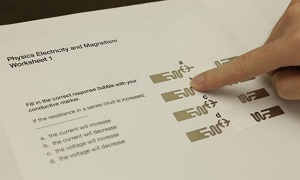
Engineers at the University of Washington with the contribution of Disney Research and Carnegie Mellon University has developed paper that will respond to gestures and could be connected to the internet. They are calling it Paper ID and have published the work under the title: A Technique for Drawing Functional Battery-Free Wireless Interfaces on Paper.
Lead author of the study, Hanchuan Li, who is a doctoral student in computer science and engineering at UW, said: "Paper is our inspiration for this technology. A piece of paper is still by far one of the most ubiquitous mediums. If RFID tags can make interfaces as simple, flexible and cheap as paper, it makes good sense to deploy those tags anywhere."
The researchers use inexpensive ultra-thin battery-free radio frequency identification (RFID) tags to create "paper input devices" as they have put it. The researchers say their physical constraints have been issues such as circuit size, wiring and power. However, the researchers have worked past these problems using the RFID tags that can pick up gestures and movement around the antennas that have been printed. Li says, "These little tags, by applying our signal processing and machine learning algorithms, can be turned into a multi-gesture sensor. Our research is pushing the boundaries of using commodity hardware to do something it wasn't able to do before."
As a result, the technology already shows amazing promise, and with Disney Research as a contributor, we're sure there is no lack of money with pushing smart-paper forward. It could have many different uses in many different industries.
Source: University of Washington
- Details
- Written by: Quintus Potgieter
Robots may be working amongst you in your office very soon. Maybe that's why you have time to read this article right now, because some automated process is already happening, doing some aspects of your job for you. Physical robots that assist with everyday tasks will also see the light of day. It's not a matter of if, it's a matter of when. The one thing that these robots currently lack is hand dexterity. They cannot grip well and it is hard for them to utilize their hands like a normal human could. Some biomedical robots used for surgery can reach into the human body with an unparalleled dexterity, however, robots with actual hands modeled after human hands are a bit clunkier.
Therefore, a team of computer science and engineering researchers at the University of Washington went to work to attempt to build a robot hand that has dexterity and which can store and learn from the mistakes it makes if it does happen to drop something.
Talking to Design Engineering, Vikash Kumar, a UW doctoral student in computer science and engineering said: "Hand manipulation is one of the hardest problems that roboticists have to solve. A lot of robots today have pretty capable arms but the hand is as simple as a suction cup or maybe a claw or a gripper."
The lab in charge of studying the human hand and how to design it into a robotic hand model is the University of Washington Movement Control Laboratory. The engineers developed several algorithms that enabled the computer to send complex hand movements to the hand itself. The results are staggering, as shown in the video below.
The team then uses sensors and motion captures so that they can extract data from their research and learn from it in their future endeavours in attempting to improve the dexterity of robot hands modeled after human hands. The robot hand has five fingers and looks to be able to understand how humans grip onto objects.
"Usually, people look at a motion and try to determine what exactly needs to happen -- the pinky needs to move that way, so we'll put some rules in and try it and if something doesn't work, oh the middle finger moved too much and the pen titled, so we'll try another rule," says lead author and lab director Emo Todorov. "It's almost like making an animated film -- it looks real but there was an army of animators tweaking it. What we are using is a universal approach that enables the robot to learn from its own movements and requires no tweaking from us."
Kumar explains how the robot learns from its actions to ensure that it grips objects in the correct way. He says: "It's like sitting through lessons, going home and doing your homework to understand things better and then coming back to school a little more intelligent the next day." The computer uses the motion capture cameras and the algorithms and refines the process based on what the algorithms command it not to do.
- Details
- Written by: Quintus Potgieter
Where in the world are the engineering mentors? Experts are saying that engineering mentorship is something that could lead to more competent engineering workforce in every industry. Not only is mentorship being encouraged at the college level but also at the working level. It is seemingly never too late to teach an old dog new tricks.
 An impressive feat of instilling an attitude of mentorship occurs at Penn State University. At the Penn State Mechanical Engineering Society (PSMES) the alumni of the society have been forming mentorship programs for the last eight years. The Department of Mechanical and Nuclear Engineering oversees this project and can see 39 alumni mentors to 54 students.
An impressive feat of instilling an attitude of mentorship occurs at Penn State University. At the Penn State Mechanical Engineering Society (PSMES) the alumni of the society have been forming mentorship programs for the last eight years. The Department of Mechanical and Nuclear Engineering oversees this project and can see 39 alumni mentors to 54 students.
Brandon Angle, a mechanical engineering junior in the PSMES program told the Penn State website: "My mentor and I often communicate right before a big event and he'll give me the confidence I need. It helps to have the guidance from someone who's been there and who went through all the experiences that I'm going to go through and just knowing that if I take his advice it's probably going to lead me somewhere where I want to be."
An alumnus involved with the project, Robert Swope, who has his qualification in mechanical engineering, said: "Almost all of the students I've mentored have not really focused on what they want to do. They have a vague idea of their goals, but they can't verbalize what their career would be."
Mentoring, of course, is not limited to the college set-up but can also be practiced within a company. The Dean of Engineering at the Engineering Institue of Technology, Steve Mackay, talks of 'mentoring vigorously'. He says the process can be done by: "Taking your young engineers, the new guys, the new chums on the block who have joined the company, and give them some support. In the old days, we had lovely two, three three-year training programs for engineers, of course, most of those are gone. So, it's up to us."
"Helping a poor young graduate who's probably come from a very high theoretical background, done some exotic mathematics at a university for three or four years and finds the workplace completely different. So, the trick is, to come along and give them a helping hand and get them to work productively as engineers as soon as possible," Mackay said, in the tenth episode of his YouTube series, the Engineering News Network. He also gives a checklist of mentoring guidelines that can be handed down to a young engineer so that they can learn the ropes:
- Give them some worthwhile projects to do
- Give them a vision
- Give them ongoing support
- Help them with troubleshooting
- Give them some basic skills: project management, communications skills
- Try and get them to do a lot of hands hands-on projects
Elsewhere in the world, Bosch is setting up 75 "vocational training opportunities" where students will interact with professionals, mentors and higher-ups in subjects like mechatronics and industrial mechanics. The new 75 positions exclusive to Italy and Spain join the handful of other projects they run in Germany. The company is certain their mentoring and setting up of apprenticeships will deal with societal issues like youth unemployment and build a good wave of competent engineers in countries that would be improved by the assistance of engineers.
- Details
- Written by: Quintus Potgieter
Career Junction is a website in South Africa that has released their 2016 Salary Review for engineers. The research was conducted between October 2015 and February 2016 to investigate how engineering salaries start out at beginner positions, and then how the salary changes in a senior position.
Engineering
| Job | Strarting - Skilled | Top - Senior | Percentage increase |
| Structural engineering | $2,328.80 | $4,682.41 | 101.07% |
| Civil engineering | $2,065.79 | $3,656.51 | 77.01% |
| Electronic engineering | $1,936.58 | $3,262.89 | 68.64% |
| Project engineering | $1,974.01 | $3,133.62 | 58.74% |
| Mechanical engineering | $2,607.04 | $4,116.20 | 57.89% |
| Chemical engineering | $1,836.12 | $2,714.25 | 47.83% |
| Electrical engineering | $2,429.89 | $3,563.25 | 46.62% |
| Industrial engineering | $2,351.24 | $3,174.21 | 35.18% |
Building Construction
| Job | Starting - Skilled | Top - Senior | Percentage increase |
| Structural engineering | $2,330.44 | $4,685.78 | 101.07% |
| Architectural technologist | $1,071.59 | $2,042.84 | 90.86% |
| Civil engineering | $2,066.37 | $3654.43 | 77.01% |
| Artisan | $1,220.95 | $1992.63 | 63.20% |
| Quantity surveying | $1,481.22 | $2,375.55 | 60.69% |
| Electricians | $1292.28 | $2,058.25 | 58.97% |
| Quality control & assurance | $1347.72 | $2105.94 | 56.26% |
| Draughtsman | $1364.21 | $2060.40 | 51.03% |
These numbers are limited to South Africa, however, they could give engineers around the world a good idea what salaries look like elsewhere in the world and could apply to the industries they are currently working in. It should give an idea of what to expect based on what engineers are making in South Africa. Or the situation could be improved elsewhere in the world, meaning engineers would be happy where they are right now and not considering travelling overseas to find better opportunities.
- Details
- Written by: Quintus Potgieter
Are you an engineer actively seeking to fill a position at a company that has its priorities straight when it comes to the environment? A global engineering firm named Arcadis might be the one for you. Their particular focus is on water, infrastructure and construction projects. And they're hiring.
 John Jastrem, Arcadis' North American CEO, told CNBC: "We're looking to hire approximately 400 engineers and scientists this year." He also confirmed that payroll would increase by 10 to 15% for the next five years. The company currently works on cleanup of sites in the mining sector to ensure the environment is protected after the first phase of engineering is completed. They also investigate the impact an engineering project will have on the environment, especially in oil projects.
John Jastrem, Arcadis' North American CEO, told CNBC: "We're looking to hire approximately 400 engineers and scientists this year." He also confirmed that payroll would increase by 10 to 15% for the next five years. The company currently works on cleanup of sites in the mining sector to ensure the environment is protected after the first phase of engineering is completed. They also investigate the impact an engineering project will have on the environment, especially in oil projects.
The company currently has 27,000 employees working in over 70 countries and improve the quality of life. They concern themselves with environmental and social impact assessment business.
A recent hire by the company, Allesandro Casartelli, told Arcadis' official website: "The impact of business on the environment and the communities it serves has never been more important. Having a better understanding of these issues will not only help make corporates make better decisions but will also improve the quality of life for those who these businesses touch. I am very much looking forward to getting started and helping to develop this key part of the Arcadis business on behalf of our clients."
The company also reportedly brings in high school students who are currently studying STEM subjects to shadow the company for a day and see how their future-focused engineering firm works. On top of that, they also recruit students who have just graduated from college and put them straight into a STEM career.
"We compete with Silicon Valley, we compete with the pharmaceutical industry," said Jastrem. "We really look for people who are on a lifetime mission to make the world a better place to live and have that desire to learn and innovate and to make some changes.
 Regardless, if you work for Arcadis or whether you find another engineering company that actively cares for the environment, it must be a good feeling to be involved somewhere that doesn't include harming the environment. The importance of being happy in a job and knowing that it is contributing to the greater good is valuable.
Regardless, if you work for Arcadis or whether you find another engineering company that actively cares for the environment, it must be a good feeling to be involved somewhere that doesn't include harming the environment. The importance of being happy in a job and knowing that it is contributing to the greater good is valuable.
The Dean of Engineering at the Engineering Institute of Technology, Steve Mackay, speaks about the rule of two third for happiness, in his 33rd episode of the Engineering News Network. He says: "If you are happy in your job, that's one, if you are happy where you live, that's item number two, and item number three is, if you're happy with who you're with...if you can achieve two of those three, then you are happy and should be very grateful."
Mackay puts this in the context of being in an engineering position. He also says that health is an important issue for engineers as well, an engineer should be healthy on top of being happy with where they are at in the engineering industry.
There are engineering opportunities out there but finding the right one that enables a balanced life and being comfortable in your workplace environment, is the tough part. Mackay concludes his cautionary words on happiness with a quote. He said: "One of the symptoms of an approaching nervous breakdown is the belief that one's work is terribly important."
- Details
- Written by: Quintus Potgieter
Tesla Motors Inc. Vice President of Production, Greg Reichow, and Vice President of Manufacturing, Josh Ensign have both left the company ahead of the announcement from Elon Musk that they would be ensuring 500,000 vehicles would be sold by 2018. This would mark five vice presidents that have exited the company in the space of three months. One of the former VPs was just scooped by Apple Inc. in a move that makes the critics wonder if an electric iVehicle could be making its way to the market by 2017.
 Apple Inc. also lost an employee to another big company this year. Danny Coster, the industrial designer for Apple joined GoPro. Seemingly, engineers are always looking for a company that will offer them the best work environment, the best pay and the most likely, the most open space for innovation. These are engineers who would probably prefer to keep their job hunting efforts on the down low, so that, the companies who currently employ them don't get wind of their desire to resign. This can be a very hard task for some. Imagine an engineer gets found out for wanting to jump ship and gets fired from his job but hasn't secured a job in the company he was thinking of sending his curriculum vitae to. It's a stress-inducing prospect for any person.
Apple Inc. also lost an employee to another big company this year. Danny Coster, the industrial designer for Apple joined GoPro. Seemingly, engineers are always looking for a company that will offer them the best work environment, the best pay and the most likely, the most open space for innovation. These are engineers who would probably prefer to keep their job hunting efforts on the down low, so that, the companies who currently employ them don't get wind of their desire to resign. This can be a very hard task for some. Imagine an engineer gets found out for wanting to jump ship and gets fired from his job but hasn't secured a job in the company he was thinking of sending his curriculum vitae to. It's a stress-inducing prospect for any person.
Steve Mackay, the Dean of Engineering at the Engineering Institute of Technology highlights this problem in the 32nd episode of the Engineering News Network. He highlights certain scenarios that would lead an engineer to search for other means of employment. He says: "You're perhaps an engineer or a technician, you've been in the same company for many years, you think there's a purge coming. The price of whatever you're selling is going through the roof or the competitors are pouring in and you're worried about the future. But you need to be very careful about your job search."
In the video, Mackay gives tips on keeping your job search confidential so your current employer doesn't pick up on the fact that you are wanting to jump ship. We will paraphrase some of them here:
- Network with trusted peers
- Big brother is watching: Companies have access to internet activity, sites you're visiting.
- Phone confidentiality: Make sure there is no one listening in
- Only work with professional executive search firms. Make sure you emphasise that you are a confidential candidate.
- Social networking sites: Employers can see what you are putting online on a public domain
- Exhibitions and conferences: An exhibition stand could give you a lot of information about a potential job
Career Directors also published a list of things to look out for when attempting to secure other employment without the current employer making a snap judgement and firing you for wanting to leave the company:
- Keep your own confidence
- Tell recruiters your search is confidential - Which Mackay highlights as well
- Ask your prospective employer to keep your job search in confidence
- Develop a confidential version of your resume
- Maintain or expand your efforts and work style while you conduct your job search
- Conduct your search from home
- And most interestingly, if your boss confronts you about your job search, own up to it
Source: Career Directors
- Details
- Written by: Quintus Potgieter
How much is your intellectual property worth? Surprisingly, quite a bit. In the engineering field, a lot of invention occurs in research facilities by the employees or students of that university. The intellectual property of a student usually becomes the property of the university that the invention or idea was crafted in. However, there are engineers out there that are continually innovating and creating intellectual property that can be patented or copyrighted etc. Therefore, engineering mentors are encouraging students of engineering faculties to become more accustomed to patent, copyright, trade secret and trademark laws so that they cover themselves sufficiently and can publish their ideas and products to the public.

Nkosana Makate has been embroiled in a fifteen year battle with South African telecommunications company and cell phone service provider, Vodacom. Makate was an employee of the company when he invented the 'Please Call Me'. It utilized the USSD (Unstructured Supplementary Service Data) technology within GSM communication technology to send a free communication to another cell phone, that would alert a user, that their friend/colleague had no funds/airtime to call them, thereby hoping that the caller who did have funds/airtime would call them back.
Makate then claimed he had the idea for the 'Please Call Me' and had said Vodacom vowed - in a verbal agreement - to pay him for the idea in the year 2000. He never saw the money. The invention of 'Please Call Me' allegedly made Vodacom over $4 billion of revenue, of which not a single cent was paid to Makate. He took Vodacom to three different courts which dismissed the claims that he should be paid for the idea, resulting in Makate taking the battle to the Constitutional Court of South Africa.
The Constitutional Court then ruled that Makate would have to be paid for the idea.
Justice Chris Jafta of the Constitutional Court said: "Having admitted that it had used Mr. Makate's idea to develop the 'please call me' service, it was not ethical for Vodacom to refuse to compensate him. What compounds the matter is the fact that Vodacom entered into a contract with him, under which it now sought to avoid liability by raising technical defenses."
The agreement that Makate wants to settle on is 15% of the calculated revenues the 'Please Call Me' service made in its 15 years of operation. When asked about the advice he would give to other people who would be selling their ideas to big corporations, Makate said: "Based on the experience that I've had, people need to protect their ideas and they need to make sure they get lawyers for advice and other people who are skilled and knowledgeable in business to actually take them through the process."
 So the question to be asked is: What should engineers know about intellectual property before entering the workplace? You could be sitting on a goldmine idea within a company that could make that company millions or even billions.
So the question to be asked is: What should engineers know about intellectual property before entering the workplace? You could be sitting on a goldmine idea within a company that could make that company millions or even billions.
Industry expert, Robert J. Sinnema, Vice President & Counsel of intellectual Property at Sikorsky Aircraft Corporation said engineers should file for a patent as soon as possible before any use of the idea. In the United States, a patent should be filed within one year of the use of the product or idea. He describes getting a patent as having a twenty-year monopoly on a certain idea.
"You may be horrified about the value you've got with your intellectual property. You need to look after it and protect it from your friends across the river who may be keen to steal it or use it in their commercial undertakings," says Steve Mackay, the Dean of Engineering at the Engineering Institute of Technology.
Mackay highlights three forms of intellectual properties in his YouTube series, the Engineering News Network. In the 28th episode he cautions engineers to protect their ideas through the following methods:
- Patents - 20 years protection. It gives you protection no one else can get once you've been granted it, but you have to do it internationally. The other issue is, once you've defined the patent, you may find that your friends who don't care about patents or any IP now have a defined product they can now go and copy. Mackay also says it is mostly iron clad.
- Copyright: A drawing or a design. You can typically get 95 years protection for a corporation and then for individual its the lifetime of the individual plus seventy years. The other good thing is, in countries like Australia you don't even have to register it, however, in the United States you do.
At Iowa State University, Attorney Rich Beem speaks of copyright saying: "Copyright makes it illegal to copy but not illegal to design around. If you have a Windows program on a CD and you install the Windows program on another computer you've just become guilty of copyright infringement. What a patent can do that a copyright cannot, is, protect the process or the method claimed for the inventive software."
Rich concludes by saying if the intention of an engineer is to make money on the idea, then patents is what they want. He says, "The best practice if you're going to publish is to file a patent application first and then publish and commercialize."
- Details
- Written by: Quintus Potgieter
The University of Washington has been harbouring some forward thinking engineers lately. The amount of invention coming out of the university has been astounding recently. Now, researchers at the university have come up with something that could save lives all over the world. The computer science and engineering and electrical engineering students have developed what they call SpiroCall'. A tool that measures lung function over a standard telephone call.
In the abstract of a paper they will be publishing this May, the researchers say:
Lung impairments account for roughly 10% of global deaths. The severity of these diseases is usually measured and managed using spirometers, devices that measure patient lung infection. Home spirometry is gaining acceptance in the medical community due to its ability to detect pulmonary exacerbations and improve outcomes of chronic lung ailments.
We have developed a smartphone app, SpiroSmart, that allows measurement of common lung infection measures using the phone's microphone.
Recently, we have developed a call-in service to allow patients to perform spirometry on any phone -- using the standard telephony voice channel to transmit sound of the spirometry effort.
The issue with spirometry over the phone would obviously be accuracy. There is no possible way that someone breathing into a telephone would produce the correct measurements, right?
Allegedly, the team's SpiroCall - which utilizes any telephone microphone - is within 6.2 percent of current clinical spirometers that are used in the medical industry today. That is enough accuracy to meet the medical community's standards according to the University of Washington.
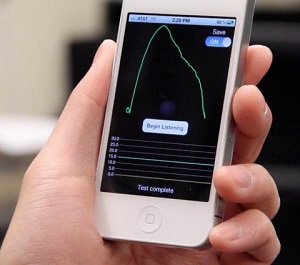
Shwetak Patel, a Professor of Computer Science & Engineering and Electrical Engineering at UW said: "We wanted to be able to measure lung function on any type of phone you might encounter around the world -- smartphones, dumb phones, landlines, payphones. With SpiroCall, you can call a 1-800 number, blow into the phone and use the telephone network to test your lung function."
The 1-800 number would be useful for people who do not have funds to call and can call for free, meaning that the product also benefits the low-income communities of the world. "People have to manage chronic lung diseases for their entire lives. So there's a real need to have a device that allows patients to accurately monitor their condition at home without having to constantly visit a medical clinic, which in some places requires hours or days," said Mayank Goel, a UW engineering doctoral student.
The team also reportedly printed a 3-D printed whistle that would make up for the bad call quality on some telephones and give the researchers a clearer idea of a patient's lung function. And it would help patients who are unable to utilize their vocal chords to produce a loud breathing sound effect that is needed in spirometry.
- Details
- Written by: Quintus Potgieter
Good advice for engineering graduates - who are now entering the workplace - comes in many forms and from many industry professionals. Older engineers who have been in the industry for a long time, also need good advice so that they can remain in the positions they currently hold. Engineering UK estimates that 65 % of engineering graduates find employment within six months. According to Engineering and Technology Magazine STEM qualifications have been in-demand for jobs that don't even pertain to engineering, and so, the draw card of a 'fat-salary' takes engineers out of the industry and employs them in financial sectors. Allegedly one in nine employed graduates is working in engineering professions.
Marcus Body, speaking to Engineering and Technology Magazine, said: "Reality is every year, virtually every grad role is filled -- it's just that despite all this talk of skills shortages, the engineering schemes aren't big enough to recruit all graduates. So they go and do other things because there literally aren't enough jobs for all of them to get in engineering."
It seems the trick for graduating engineers getting into the profession, or older engineers wanting to stay in the profession, is broadening the skillset. DesignNews writer Jacob Beningo published an article detailing the 7 skills every engineering grad needs, to be successful.:
- Networking
- Resume Writing
- Cover Letter Writing
- Interviewing
- Salary negotiation
- Communication
- Entrepreneurship
 We have covered these skills extensively on EngineeringCareer.org, except for one skill that seems to be under-emphasised: Networking.
We have covered these skills extensively on EngineeringCareer.org, except for one skill that seems to be under-emphasised: Networking.
The Dean of Engineering at the Engineering Institute of Technology, Steve Mackay, has also underlined the importance of networking in the industry. In his YouTube series, the Engineering News Network, he said: "One of the amazing things you can do is build up a network of colleagues and friends. You start doing that when you are at college and university and you keep building it up. The network of friends and colleagues will actually help you get employment or point you towards opportunities."
Mackay also says that over 70% of opportunities are not advertised widely on job sites and are rather found through the networking an engineer has done. "One of the most amazingly important things in your career armory is to have a network. To keep building it, maintaining it and working it and to be part of the network to help other colleagues that might need jobs or opportunities."
- Details
- Written by: Quintus Potgieter
Have you ever been in the position where you've had to communicate with a person from the deaf community? It is a daunting task for some to attempt communication with a person who has that disability due to not understanding sign language. Two students from the University of Washington intend to redesign the way deaf people communicate with tech-gloves called Sign Aloud. The students (Thomas Pryor and Navid Azodi) won a competition named the Lemelson-MIT Student Prize that searched the United States for new inventions from students. The Sign Aloud gloves can be worn by a deaf person, who then would talk sign language and the tech attached to the gloves would convert the sign language movements into text or speech.
Talking to UW Today, the students said: "Our purpose of developing these gloves was to provide an easy-to-use bridge between native speakers of American Sign Language and the rest of the world. The idea initially came out of our shared interest in invention and problem solving. But coupling it with our belief that communication is a fundamental human right, we set out to make it more accessible to a larger audience."
To see what it is capable of, check out this video:
The two students are calling it an American Sign Language Translator. The gloves have sensors connected to the hands and the wrist that measure hand position and movement. Then through Bluetooth, the data is sent to a program coded by the students that convert the movements into actual text or speech.
Some online commenters are saying $10,000 is not enough money to jumpstart the project and have encouraged the students to either start a Kickstarter page or take the idea to Shark Tank - a reality program for inventors - to get their gloves funded.
Pryor and Azodi say that the gloves for right now are a prototype and require clunky elements like a laptop and the gloves themselves. The students say that the future of the product could be an app on a smartphone. However, their prototype right now seems to be a working, functional method of converting sign language into text and speech, that is understandable to able-bodied people.
- Details
- Written by: Quintus Potgieter
As the world becomes more fast paced and more interconnected through the internet, some students decide that online tertiary institutions would probably fit them more than an on-campus solution to engineering studies. These students are usually cautioned and told that online qualifications do not lead to employment in the industry and that online studying still has a long way to go before it is fully recognised. However, engineering qualifications over the internet have become more respected over time. Open distance learning in the engineering field is becoming more frequent in the world where engineers are required to be on site, working, and broadening their knowledge as their industry changes.
USNews spoke to Jack Cullen, president of Modis, a tech staffing agency. He said: "Now that you're seeing more and more people in that hiring chair that have come from perhaps their own online education, you're seeing a lot more acceptance of it."
 Cullen believes that online engineering education solutions are beneficial due to an engineer being able to "work and pursue a degree at the same time". He also says engineers studying towards a master's degree usually apply what they are learning to the work they are currently doing.
Cullen believes that online engineering education solutions are beneficial due to an engineer being able to "work and pursue a degree at the same time". He also says engineers studying towards a master's degree usually apply what they are learning to the work they are currently doing.
Dani McDonald, vice president of national engineering recruitment at Kelly Services, said: "The degree at the end of the day is really just a credibility statement. They're looking for your experience and what you've contributed and what you will contribute to their organization." However, she also says employers like to see a name of a university they are familiar with.
Charles Muwandagara, an engineer who is currently working on power stations across Africa, recently graduated with his advanced diploma in mechanical engineering from the Engineering Insitute of Technology (EIT), an online institution. Through broadening his knowledge in the industry he was currently working in, he was promoted to project supervisor.
When asked about his diploma and whether he felt it was a necessary addition to his skillset through online education, he said: "It was very practical. To run a project you need those basic skills."
Muwandagara also says that studying engineering whilst already in an engineering role can lead to promotion. He said: "There is promotion. I could be superintendent on my next project." He also said that he is setting his sights on a master's of industrial automation through online institutions whilst working in the field, certain that it would boost his career. Colleagues of Muwandagara have also taken to online institutions due to noticing how beneficial it can be to further build on their curriculum vitae.
- Details
- Written by: Quintus Potgieter
The G7 (Group-of-Seven) nations have vowed to uphold a promise that would see agricutural innovation and investment be prioritized around the world.
The statement made by the G7 read: "Motivated, skilled and enterprising farmers are essential for the growth of the agricultural sector. We will help farmers enhance their capability and skills by facilitating access to information and communication technologies, precision farming and agricultural innovations."
That's where the agricultural engineers come in. Farming technologies need to be developed to assist food security in the world of today so that in the future, there is enough food for the growing population.
Makiko Tsugata, a senior analyst at Mizuho Securities said: "There are no other options for farmers but to rely on technologies developed by companies if they want to raise productivity while they are greying. The government should help them adopt new technologies."
The University of Georgia's engineers are warning that food production in the agricultural industry cannot keep up with the rate at which humans are being born. According to OnlineAthens, the world's population will spike from the current 7 billion people, to 9.5 billion in 2050.
UGA agricultural engineer, K.C. Das spoke at one of the university's conferences and said that food production needs to increase by 70 percent if the world intends on accomodating 9.5 billion people by 2050. Das spoke to the American Society of Agricultural and Biological Engineers, saying that changes will have to be made in food production in order for the industry to survive with that heavy of a demand.
 "We have to do it by increasing the intensity of production, and this can have all kinds of unintended consequences for the environment," said Das.
"We have to do it by increasing the intensity of production, and this can have all kinds of unintended consequences for the environment," said Das.
Another concern for agricultural engineers is that to produce these foods and to transport them around the world, fossil fuels are still being utilized. Clean, renewable energy is the logical step forward. Das said, "You're using as much gasoline in the food you consume as you are using driving."
He says 19 percent of all U.S. energy and 70 percent of the world's water is used up by the agriculture industry. Another incredible statistic from UGA is that 8 percent of greenhouse gas emissions are also as a result of food production.
Changying Li, a scientist at UGA, said: "The amount of agricultural land is stagnant, and turning more land into agricultural use isn't really the answer -- but greater efficiency can help the world meet the challenge. Increasing food production is one of the greatest challenges facing producers and engineers."
- Details
- Written by: Quintus Potgieter
Engineers are obsessed with reducing computing down to the size of one solitary chip these days. The smallest of transistors can operate at gigahertz far greater than computing speeds. The buzzword around engineering is 'nanoscale'. Everything is smaller and more efficient, engineers are always looking to minimize the amount of space something takes up. However, the smaller the object, the more 'nanoscale' some of the materials have to be to accommodate the size.
 Researchers at Stanford University have investigated phase-changing nanoparticles to observe how their shape changes due to the arrangement of atoms within the crystals inside. They relate this to the charging and discharging of energy storage systems. This research would be valuable to any companies currently working with lithium-ion, hoping to release energy cells to the public.
Researchers at Stanford University have investigated phase-changing nanoparticles to observe how their shape changes due to the arrangement of atoms within the crystals inside. They relate this to the charging and discharging of energy storage systems. This research would be valuable to any companies currently working with lithium-ion, hoping to release energy cells to the public.
The work published in the Nature Materials journal was named Reconstructing solute-induced phase transformations within the individual nanocrystals.
Nanoparticles within energy storage systems enable the systems to charge faster and last longer. This process inspired the researchers to look into how deformed the crystals within the nanoparticles become during this process. They rationalize that if they can discover a breakthrough, they could improve charging and discharging and lifespan of batteries.
The abstract said:
Strain and defects can significiantly impact the performance of functional nanomaterials. This effect is well expemplified by energy storage systems, in which structural changes such as volume expansion and defect generation govern the phase transformations associated with charging and discharging.
The rational design of next-generation storage materials therefore depends cruciailly on understanding the correlation between the structure of individual nanoparticles and their solute uptake and release.
Jennifer Dione is an assistant professor of materials science and engineering at Stanford and worked on the project. They took lithium-ion batteries and tested the reactions of individual particles during charging. Using an environmental transmission electron microscope, they were able to observe the nanoparticles and at what hydrogen pressures they were reacting under. They found that the structure of a nanoparticle does have an effect on how an energy storage unit would perform. The difference is how hydrogen is absorbed in the center of a nanoparticle, which causes performance issues.
Tarun Narayan, a lead co-author of the study, told Stanford News: "This instrument is one of only a handful of its kind and allows us to study materials in their working environment.
Andrea Baldi, a postdoctoral co-author and faculty member of the Dutch Institute for Fundamental Energy Research (DIFFER) said: "Each technique offers different information that can be combined to gain a complete, multi-dimensional understanding of the system."
Robert Sinclair, a professor of materials science and engineering who also wrote alongside colleagues at Stanford said: "We could not have envisaged making in situ observations like this at the atomic level even a few year ago, and so what the teams had demonstrated and achieved is remarkable in the materials imaging field."
Dionne concluding by saying: "With this ability to peer inside nanoparticles during their operation, we can help design champion materials for next-generation energy storage devices."
- Details
- Written by: Quintus Potgieter
The delicate balance between engineering education and work experience has proven to be a conundrum in multiple engineering industries, where jobs are not being found. What engineering education should students then be getting to secure their engineering job in the industry? That is the question a lot of students have been asking, due to not finding employment in the industries they studied for.
Shady Hashem, a student from Egypt, travelled to Canada to study at the Halifax Dalhousie University and then tried to find a job at the University of Calgary. He admitted to applying to over 50 jobs in Canada but hasn't found success in employment thus far.
Hashem said: "I talk to a lot of engineers, and the expected time to get a job is between six months and a year. I'm applying everywhere, but I haven't heard back from anybody yet, not even an email that says: 'Sorry this position has been filled.' That's very frustrating."
Hashem is looking for a job in the oil industry, however, the Conference Board of Canda released a report saying that the demand for employment is double the national average of the last 17 years in civil, mechanical and computer engineering. Thus, the lack of jobs might only be in selective industries.
Colleen Bangs is the manager of career services at the University of Calgary and said that one-third of the university's 659 engineering students have not been employed since graduating.
Bangs said: "Something I've noticed, particularly in this last semester, is that there's a bit of an impending feeling of doom."
The report as published by CTVNews also states, that the University of Alberta has revealed that 70 percent of the 1,300 engineering students have in fact found employment in engineering industries. These revelations lead critics to believe that the situation is not as bad as it seems. Could it be that the University of Calgary isn't as respected as other universities are? Is their engineering education good enough?
In South Africa, a known civil engineering hiring slump has occurred since the end of the Fifa World Cup in 2010. The Sunday Times recently reported on a civil engineering graduate named Mfuneko Nomvalo, who has returned home after studying due to not finding employment.
Nomvalo told the Sunday Times: "It's been five years since I graduated, but finding work has been the hardest thing for me. I thought I had left and progressed in life. I've worked 18 months on contract on local construction jobs and it's not what I thought it would be like..."
 How does a future engineering professional find the right education institution fit for them? Finding a university that will guarantee a hire in the industry, is a tall order it seems. What needs to happen in engineering education to produce more skilled, work-ready engineers?
How does a future engineering professional find the right education institution fit for them? Finding a university that will guarantee a hire in the industry, is a tall order it seems. What needs to happen in engineering education to produce more skilled, work-ready engineers?
The Dean of Engineering at the Engineering Institute of Technology, Steve Mackay, addresses the topic of engineering education that works in the thirteenth episode of the Engineering News Network.
Mackay said: "We really need to focus on the basics, which is, having outstanding industry experienced instructors involved with the students. That's what really matters...people who have industry experience."
Regardless of the university, Mackay seems to believe that as long as engineers equip themselves with the necessary skills, they would be able to find employment in the industry. He believes:
The typical things you want to teach the students are things such as being entrepreneurial, creativity, being able to think outside the box, working in teams - the instructor and the students - forget about the good old professor on the stage it's actually the professor and the lecturers and instructors all working together on the project. There's no more guru that you have to listen to quietly, it's actually all about dynamic teamwork.
Other skills that are required are things like project management, which often as engineers and technologists we are involved with in our day to day jobs.
Communication skills ; reading and writing. Engineers need to jack up their communication skills.
- Details
- Written by: Quintus Potgieter
Engineers have some of the most sought after skills in the world today. You could say they are necessary, most influential actors in our global society. Their contributions do not go undervalued seeing as though they place in the top 5 highest paying jobs of 2016.
However, engineering experts themselves admit that they are missing some necessary skills that their tertiary education and work experience didn't prepare them for.
Professor Lawrence Susskind, a professor at MIT in the Urban Planning sector and the head of environmental policy and planning group, wrote an article entitled The Key to Success: Negotiating 101 for Engineers, published by TheEngineer.
He writes, "It's one thing to come up with an innovative idea; it's another to take that idea to the market." Susskind says there is a typical engineering logic that gets in the way of marketing and maintains that engineers repeat the same mistakes every time they negotiate with potential investors and partners.
Susskind's list of how to avoid the mistakes of bad negotiation is as follows:
- Ego and emotion: When negotiations begin, it's vital to leave emotions out of it.
- Dealing with Uncertainty: When entering a negotation, it's key for inventors and innovators to be ready with contingent proposals that will minimse the risk to their investors.
- Handling technical complexity: It may be necessary for both sides to engage in joint fact finding to ensure that they have shared understanding grounded in mutually acceptable data.
- Building Trust and Working Relationships: To maintain good working relationships, sucessful negotiators know how to say what they mean and mean what they say.
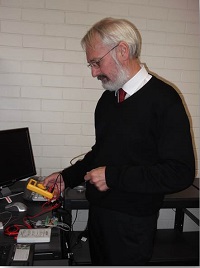 Negotiation is not the only skill that engineers should add to their arsenal of skills, it seems. The Dean of Engineering at the Engineering Institute of Technology (EIT), Steve Mackay, also highlighted what skills - as basic as they might be - engineers could become proficient in to ensure engineering success.
Negotiation is not the only skill that engineers should add to their arsenal of skills, it seems. The Dean of Engineering at the Engineering Institute of Technology (EIT), Steve Mackay, also highlighted what skills - as basic as they might be - engineers could become proficient in to ensure engineering success.
In the sixteenth episode of Mackay's YouTube series, Engineering News Network (ENN), he underlines some key non-engineering skills engineers can quite easily pick up. Mackay speaks of a touch-typing course he took forty-two years ago, that was one of the most fantastic skills he ever picked up. The other skills he encourages, are the following:
- Time management: "Someone mentioned to me the other day that time is probably the greatest thing we don't have much of. Money we can get, time we cant.
- Basic finance and bookkeeping: "It's horrific how many engineers are in their 50s and 60s and they have no money because they didn't do any management of their finances when they were in their 20s
- How to negotiate effectively: "The ability to negotiate for anything you want to buy. A car, an item for your house or your factory or your shop.
- Write simply and decisively: Don't use big words when you write reports, make it simple and readable
- Presentations: How to present powerfully and simply. Don't use powerpoints with glitzy animations. Try to avoid being lost in powerpoint
- Capture with photographs: Taking photographs and looking at basic skills with lighting and framing...very important.
- Networking: All the time, all day, everyday. Keep up with what's going on in the job market, what's going on everywhere. Networking will keep you employed for the rest of your life.
Networking and negotiating are key areas that seem to be an area of concern to engineers around the world and is something that experts are encouraging engineers to perfect. Even the most basic of skills that could have gone unlearned during high school or tertiary education expansion can be beneficial to engineers, according to the engineering opinion makers.
- Details
- Written by: Quintus Potgieter
A new string of engineering graduates will be looking for jobs in the industry very soon. Every year engineering graduates are produced and ready to bring their youthful style and their expertise into a company. In South Africa, the University of Pretoria said that they account for 27 percent of engineering graduates in the country. Recently, the World Economic Forum said the most engineering students would be coming out of Russia, but didn't account for the number of graduates in China and India. All in all, the number of engineers getting their qualifications would mean there is no shortage of engineering talent. However, the name of your university can only get you that far. Sometimes in order to get an engineering job you have to go the extra mile.
 The next step for graduates is getting that desirable job, right? But the first step is polishing the curriculum vitae and getting it out there so you can appear to be the best candidate for an engineering job. Some experts in the engineering field have weighed in and given their two cents as to how to build that attractive looking CV.
The next step for graduates is getting that desirable job, right? But the first step is polishing the curriculum vitae and getting it out there so you can appear to be the best candidate for an engineering job. Some experts in the engineering field have weighed in and given their two cents as to how to build that attractive looking CV.
The Dean of Engineering at the Engineering Institute of Technology (EIT), Steve Mackay, talks about constructing an engineering résumé in the fifteenth episode of the Engineering News Network. Here is a summary with some quotes from the Dean that might strengthen your curriculum vitae:
1. Focus on the job: "Most people think they can use a generic résumé because they are applying for lots of jobs but that is a sure fire path to destruction."
2. Make it simple: "Use simple English, lay it out simply, you don't have to address it to the village idiot but by the same token make it simple and easy and reasonable."
3. Grammar and spelling must be 100%: "Try and look at the English and the spelling to make sure it reads well."
4. Avoid excessive information: "The twenty page CV is long since gone. Employers don't have time to read."
5. Lots of white space and include an executive summary: Mackay says the executive summary should be included because it would state why you think you're the right pick for the job. "Try and be specific, give real employers names...who actually exist...plus your time with them and the job you had and the reason why you left," he said." He further says that you should try and avoid the 'job hopping' approach where your CV shows that you've only spent a few months at a place of employment because that doesn't look good at all.
6. Search for jobs you really want: "It's pointless going for a higher paying job if you hate it. Try and focus on the jobs you are looking for, make sure it's aligned with you."
7. Business strengths: Mackay says it should include 'business wins' from previous employment. Stating what kind of successes you achieved.
8. Experience: "No matter how many qualifications you've got, if you don't have the experience that matches up with the qualifications, you've got a pretty tough job selling yourself. Experience plus qualifications...great match."
Engineering.com also penned a list of things to look out for, which should equip you with the necessary skills to create a good CV for engineering employers:
- Know the target company
- Think outside the box
- If you don't ask, you don't get
- Give the employer a compelling reason to read on
If you seem to find yourself absolutely lost in the formatting stage of preparing a curriculum vitae, there are options on the internet that you can explore. For example, Google has templates available, that are crowdsourced templates that can make CVs look professional and readable so that you could perhaps secure that job. You can find them here: Résumé Templates.
The rest is all up to you. Good luck on finding a job and congratulations if you have just graduated with an engineering degree.
- Details
- Written by: Quintus Potgieter
Recently, construction industries have been reporting a drop in job numbers and a lack of jobs becoming available on a global scale. In Australia, a recruitment agency named Hays is now reporting that jobs are available in the transport, rail and civil engineers industries but it seems like qualified individuals aren't there to fill any of the positions.
 According to Sourceable, Hays is reporting job opportunities for design engineers with civil engineering experience in road building. Rail engineers are also being asked for with "track or electrification" experience. The official number of jobs becoming available sits at ten percent up compared to 2015, according to the Department of Employment in Australia.
According to Sourceable, Hays is reporting job opportunities for design engineers with civil engineering experience in road building. Rail engineers are also being asked for with "track or electrification" experience. The official number of jobs becoming available sits at ten percent up compared to 2015, according to the Department of Employment in Australia.
The developments in need of engineers are:
- Australia Inland Rail Expressway
- North West Rail Link
- WestConnex: road and rail links
- NorthConnex
- Upgrades to Pacific Highway in New South Wales
- Melbourne Metro Rail
- Western Distributor Project
- Gold Coast Rail project in Queensland
The Australian Construction Industry Forum has also expressed its confidence in civil engineering investment in the country. The current investment is $23.9 billion and could grow to as much as $30 billion by 2018/19.
Elsewhere in the world, Canada is also looking for engineering professionals in construction roles. The Conference Board of Canada states that employment growth has doubled the national average. The board observed the engineering employment hiring practices over a 17 year period.
"The rapid growth of this sector of the Canadian economy demonstrates why engineering and applied science technology offers so many promising career opportunities," said Ontario Association of Certified Engineering Technicians and Technologists (OACETT) president Bob van den Berg.
According to DailyCommercialNews, in 2013/14, 400,000 Canadians were employed in STEM careers. The government of Canada is sure that when the current string of older engineers retires, there will be space in the engineering career job listings in Canada.
The report in question was named Assessing the Economic Contribution of Canda's Engineering and Applied Science Technicians and Technologists. The report indicated that civil engineering jobs showed stronger employment growth than other statistics in the country from 1997-2014.
Good time to be a civil engineer in Australia and Canda. Eh?
- Details
- Written by: Quintus Potgieter
Do you have a job that you are certain cannot be done by a robot in the very near future? Do you have skills that can survive the move to automated systems? Hold on to it. Experts are warning that robots will take over most jobs within 30 years. There seems to be a shared global understanding that the robot revolution is here and is leading to unemployment and will continue to do so into our future.
Professor Moshe Vardi from Rice University works with computational engineering and is the director of the Ken Kennedy Insitute for Information Technology. He was recently quoted by the Telegraph, saying:
We are approaching a time when machines will be able to outperform humans at almost any task. Robots are doing more and more jobs that people used to do. Pharmacists, prison guards, boning chicken, bartending, more and more jobs we're able to mechanise them.
I believe that society needs to confront this question before it is upon us: If machines are capable of doing almost any work humans can do, what will humans do?
The question I put forward is, 'Does the technology we are developing ultimately benefit mankind?
A typical answer is that if machines will do all our work, we will be free to pursue leisure activities.
I do not find this a promising future, as I do not find the prospect of leisure-only life appealing. That seems to me a dystopia. I believe that work is essential to human well-being

So, which industries are truly in trouble of robot takeover? There are surely jobs that would never be able to be replaced by a robot.
A recent report by the Council of Economic Advisers at the White House said that employees who make less than $20 an hour are working in sectors that are probably most at risk of being replaced by a robot.
The Pew Research Center also conducted research, nationally across the United States. The results of the survey showed that 65% of Americans think that robots will be doing most jobs done by humans today.
Steve Mackay, the Dean of Engineering at the Engineering Institute of Technology, spoke about the fourth industrial revolution that the world is currently experiencing, that is automating some jobs that humans will most likely not be doing in the near future. In the fourteenth episode of the Engineering News Network, he says: "Mainly jobs in repetitive industries...any task that can be automated is generally repetitive, unfortunately. We need to look for other opportunities."
Mackay thinks creative industries will grow as automation replaces a lot of industries that required professionals before. He also refutes that there is no shortage of STEM skills as has bee claimed in the world today. He also says there should be a focus on entrepreneurship no matter which industry you are working in and thereby you might be able to achieve more in the world where the fourth industrial revolution automates the world.
In January of 2016, the World Economic Forum (WEF) published projections that stated 5.1 million jobs would be in trouble from 2015-2020 in 15 countries due to the rise of automation in several industries. The report was named The Future of Jobs and is freely available to read. The report also suggested a host of things the world can do to further prepare for the automation overhaul in a long term situation:
1. Rethinking education systems
2. Incentivizing lifelong learning
3. Cross-industry and public-private collaboration
Klaus Schwab, founder and chairman of the WEF, said: "Without urgent and targeted action today to manage the near-term transition and build a workforce with future-proof skills, governments will have to cope with ever-growing unemployment and inequality, and businesses with a shrinking consumer base."
The widespread cautioning has been underlined in India as well. Warning students to make good decisions of what to study might future-proof the number of working humans in the future. At the Hindu Education Plus Career Counselling 2016 conference hosted by VIT University, a career consultant and analyst, Jayaprakash A. Gandhi said: "It is not enough to nurture your dreams alone. One has to understand these realities and pursue studies based on that understanding. If you do not update yourself, you will get outdated yourself. Parents should look for educational institutions that teach beyond the syllabus and should never compromise on the best college."
- Details
- Written by: Quintus Potgieter
The robo-apocalypse is almost here if a recently designed robot grows even stronger. A team of engineers from Harvard John A. Paulson School of Engineering and Applied Sciences have built a bot that would go up against the best of the best battle bots and then just simply shoot them down.
A recent competition named the Mech-Warfare Contest was held at Sheperd Univeristy at an annual meeting called ShepRoboFest. The Harvard boys' robot was the winning robot. In the competition, the robots shot BB-guns at enemy robots which would then result in the robot getting points. The engineers would sit in a different room and would control the robots and let them fight,
The engineers are part of a team named the Harvard Undergraduate Robotics Club (HURC) and has been designing the robot for two years before they started to build it over a collection of months.
John Alex Keszler, a student studying electrical engineering in the group, spoke to Harvard's website and said: "There was a real watershed moment when we finally had the code and structure, so we put it on the table in the Active Learning Labs. sent the signal a few times, and eventually, it stood up. In a split second, it went from being a just a pile of rubble and wires to a 'living machine'."
One of the flaws the engineers does admit is that the robot's walking is not ideal. Just imagine that thing walking towards you and trying to shoot you.
"We built this robot almost completely from scratch. In a way, it is kind of like our child. This is, by far, the coolest thing I've ever built. It was such an immensely powerful moment to watch our creation compete," said Timothy Tamm, one of the students getting his qualifications in computer science. "One of the things we strive for at HURCS is to make everybody a multidisciplinary engineer. Everybody comes to us with an area of comfort and expertise, but we all got out of our comfort zones to help produce the robot. I think everyone of us has learned a new skill and become a broader engineer from working on this project."
Source: Harvard John A. Paulson School of Engineering and Applied Sciences
- Details
- Written by: Quintus Potgieter
Students from Rice University in Houston Texas have created a device that 3D printed prosthetic hands can grip onto so that the team can measure the force of the hands. The group has given the project a nickname: Carpel Diem. The all-female team initially wanted to create their own prosthetic hands but ended up making a device test already existing hands.
Two mechanical engineers, two bioengineers, and an electrical engineer make up the team that is focusing on creating the force testing device. Amber Wang, a mechanical engineer major at Rice University, said: "What we're working with is we are creating a force testing device or suite of different devices in order to test 3D printed prosthetic hands."
Along with a website of volunteer 3D printers named e-NABLE, the team has gone to work to try and refine the way that prosthetic hands grip items. Prosthetic hands were among the inventions that skyrocketed into popularity after 3D printers became known to society.
Wang says, "The prosthetic hand is not absolutely perfect in its function as a normal hand ; the kid will probably discard it and go back to his/her adapted way of using his/her palms before."
Rachel Sterling, another mechanical engineering major for the team says: "If a kid has to put in five pounds of force to only get one pound of grip, that's a lot of lost efficiency because of how these hands are designed. Until we reach more efficiency of 100 percent, the hands aren't going to be useful."
So, to test the efficiency of these prosthetics they hooked up the hand to a mechanical arm with a motor that pulls the hand in the motion it would be grabbed as if it was on an arm. It is connected to a computer that gives the information of force input and output so that the data can be observed and the limbs can be altered to one day be as efficient as a human hand. According to 3Ders, the device can test up to 60 degrees in any direction.
- Details
- Written by: Quintus Potgieter
Engineering and entrepreneurship. Some students might say that those sound like two different degrees if considered in a tertiary context. However, more and more educators and opinion makers are encouraging engineers to embrace entrepreneurship. MIT is the first to raise the concern of engineers without entrepreneurship skills. Therefore, they have launched a minor degree in Entrepreneurship & Innovation that engineers are encouraged to take so that they can maximise their potential in the world of entrepreneurship along with their engineering degree.
The Entrepreneurship & Innovation Minor (E&I Minor) educates students to serve as leaders in the innovation economy with the knowledge, skills, and confidence to develop, scale and deliver breakthrough solutions to real-world problems. They will be prepared to do so within a range of organizational contexts: an entreprenuerial startup of their own, as key members of a founding teams, or as an entrepreneurial member of a large organization."
- Excerpt from MIT's Innovation Initiative
The interesting part of the new minor MIT is offering, is that it is being taught by lecturers from MIT's Schools of Engineering and Management, but is open to all students to take.
In an interview with a website named Bostinno, Steve Haraguchi, the executive director of Innovation Initiative said that students had reached out to the university, actively seeking out opportunities to study entrepreneurship at an undergraduate level.
Part of one of the modules in the undergraduate study is 'Venture Engineering'. Haraguchi said it would be teaching students to see a business venture as a system, much like an engineer would. Making this course valuable to engineers as well, who have dealt with this sort of thinking already.
The Dean of the Engineering Institute of Technology (EIT) agrees that entrepreneurship is a key tool for engineers in the modern context. He says that companies that ensured a job for life - thirty years ago - are no longer holding on to employees as long. He admits that the situation is "dramatically different" in the modern context of being an engineer.
In the eleventh episode of the Engineering News Network: Entrepreneurship in engineering, Mackay gives a few tips to engineers, explaining why entrepreneurship is an invaluable addition to their skill set:
First of all, try and identify a gap in the market. It's very hard to do that. Look for something where there is a real need, not something you think is required but what the market needs.
Second thing is, pick an activity that is aligned with you, in other words, what you want to do. If you are designing some wonderful thing to sell on the market, make sure you are passionate about it. If you're not passionate about it or you hate what you're doing with that particular product or service, believe me, you won't sustain it.
Thirdly, you have to be persisent. Keep driving yourself, keep persisiting no matter how many kicks in the teeth you get, to get your product over the line. Most people will laugh and say this is a joke, but when you look at the most sucessful entrepreneurs, they were the ones who pushed themselves across to disbelieving clients and gained success.
Lastly, unfortunately, you have to fail. We fail nine out of ten times. Ten out of ten times in the endeavours we undertake. Failure is a key part of being a sucessful entrepreneur, so keep persisting.
In 2012, Krishna Uppuluri published a book named Engineer to Entrepreneur: The First Flight. The reviews for the book say it is, "good for first-time entrepreneurs," in case you might need some encouragement and guidance on the big step of trying to start a business.
The book has some good ideas, but also has the main misconceptions that engineers have about entrepreneurship that Forbes Magazine summarized in 7 simple points that read:
1. Everyone loves 'cool ideas' and new technology
2. I need to go-it alone to assure quality and elegance
3. Marketing is fluff and selling is black magic
4. We need to get functionality maximized before we focus on customers
5. A good engineer hates unpreditability and risks
6. We can't worry about making money until we get it built
7. Outside funding causes loss of control and undue pressure to deliver
Mackay also shares the sentiment that marketing needs to happen and enforces that it's a misconception to think otherwise. He says, "Work hard at marketing. Market successfully, and that means thinking carefully about how to get your message across to your great, potential clients."
- Details
- Written by: Quintus Potgieter
A group of female engineering students from Glasgow University are heading to Rwanda, Africa, to hand over the flame of education to girls who are interested in pursuing STEM (Science, Technology, Engineering, Mathematics) degrees.
One of the students involved, Ellen Simmons, said: "It is usually when pupils get to about 16 that they are encouraged away from STEM subjects, both at home and by teachers in school. But in Rwanda the situation is further complicated by the fact girls are expected to stay home and take on caring duties. Perhaps not in the cities but certainly in more rural areas."
The Dean of the Engineering Institute of Technology, Steve Mackay, has explained this phenomenon as the 'engineering valley of death' in his YouTube series, the Engineering News Network. "The concept is when the young adults get to about 12, 13, they lose interest in science, engineering, programming. You'll find there's a tremendous drop-off and then when they get to 18, 19, there's only a small fraction of the school cohort that goes into scientific careers."
Simmons was behind setting up a project called 'FemEng' that acts as a tool of encouragement for girls to get involved with engineering, and is now taking the movement to Rwanda. She says, "We are limited in knowing exactly how girls in Rwanda are being held back from engagement in STEM and although we have been given a fair amount of insight from Rwandans we've met within Scotland, one of the main objectives of the project this year is to gain reliable knowledge of how best to increase gender equality in the field, in terms of Rwandan students."
Further afield, in Australia, the worry is that the integration of female engineers is lagging behind. So much so, Professor Nalini Joshi, a mathematician from Sydney University, delivered an impassioned speech on the topic calling for change. Speaking to the National Press Club, she said: "I want to convince you that Australia has to pursue change because the benefits go well beyond gender, beyond sexual identity or preference, race or ethnicity, and that change will make our society become more creative, abundant, inventive, and innovative."
According to ABC, Joshi went to say that only 9 percent of professors in mathematical sciences in Australia are women and laments at how in a progressive society this was allowed to happen.
However, Joshi would be impressed to see that engineering firms in Australia are doing all they can to ensure that female engineers are brought into the company and treated on an equal level. According to a video (see below), Jetstar - that is in Newcastle in Australia - doubled the number of females in apprenticeship programs in 2016. The video shows actual proof of girls who since a young age were interested in the aerospace industry due to their fathers being engineers before them.
Aviation/Aerospace Australia chief executive Ken McLean said : "Incentives and quotas have helped reverse this situation. The challenge now is to ensure women are well represented in the technical aspects of aviation, such as maintenance, dispatch, and piloting."
Source: Scotland Herald & ABC
- Details
- Written by: Quintus Potgieter
Engineering salaries are on the rise according to industry players publishing new reports. The Economic Research Institute released a list of jobs in engineering that seemed to have gotten pay raises from 2014-2015.
The results of the national salary increase:
- Electronics and computer engineers - salary raise of 8.31%
- Mechanical engineers - salary raise of 7.38%
- Quality engineers - 7.36%
Meanwhile, StraitsTimes is reporting that in Singapore, the starting salaries of engineers in the public service sector will see a 20% hike. They explain this by indicating that currently the engineers make $3,800 a month, but that will rise to $4,000 per month, especially in the information and communications technology industry.
Deputy Prime Minister Teo Chee Hean, who introduced the new hikes, said: "Salaries for engineers and ICT professionals vary across public agencies today. Some are already paying salaries that are largely competitive with the market while the salaries in other agencies lag significantly. In specific areas, we will pay a premium for engineers with skills that are in high demand and short supply such as cyber forensics and malware analysis, or those with niche skills that are critical and specific to the Government but for which there may be little market demand."
Richard Zambacca, president of HR company Randstad Engineering, said: "As a lot of industries are growing, the demand is rising and everybody's competing for a lot of the same talent. Experienced people definitely have a chance for higher wages."
- Details
- Written by: Quintus Potgieter
Payscale has released their 2015/16 College Salary Report which takes a look at the highest paying graduate degrees by salary potential. The report focuses on graduates who have made it into their respective industries and reported back with the kind of money they are getting. The report factors in MBA, non-MBA masters' degree majors, bachelors' degree major and associate degree majors, according to the official Payscale website.
Here were the results of the highest paid positions:
| 1) Petroleum Engineering |
Degree type: Master's Early career pay: $96,500 Mid-Career Pay: $173,000 |
|||||||
| 2) Nurse Anesthesia |
|
|||||||
| 3) Strategy |
|
|||||||
| 4) General & Strategic Management |
|
|||||||
| 5) Finance & Real estate |
|
|||||||
| 6) Electrical & Computer Engineering (ECE) |
|
|||||||
| 7) Computer Engineering (CE) |
|
|||||||
| 8) Chemical Engineering |
|
|||||||
| 9) Biomedical Engineering (BME) |
|
|||||||
| 10) Economics |
|
|||||||
| 11) Economics |
|
|||||||
| 12) Finance & Economics |
|
|||||||
|
13) Electrical Engineering |
|
|||||||
| 14) Organic Chemistry |
|
|||||||
| 15) Computer Science (CS) & Engineering |
|
The fact that engineering factors quite a lot in the report is not surprising as the world continues to rely on the work of engineers. Petroleum engineering seems to be a lucrative career. "No matter what degree level you obtain in petroleum engineering, you'll probably have an easy time finding a high-paying job. It just depends on how much time you want to spend in school," Payscale says.
What are the lowest paying jobs for people with a master's degree? Payscale also worked that out:
- Early childhood education ($60,000)
- Library and information science ($57,100)
- Music ($56,900)
- Social Work ($67.900)
- Counseling ($52,300)
- Details
- Written by: Quintus Potgieter
The Air Force Research Lab in the United States has asked engineering students to assist them in creating gloves that would simplify the process of abseiling (or 'fast rope') out of helicopters on ropes.
According to the NorthlandNewsCenter in the U.S., the Air Force says the gloves that already exist suffer from too much friction heat.
Air Force Major, John Zimmerman, said: "You put a guy my size on a rope with 150 lbs on my back, 20-90 feet in the air. That's a lot of energy that has to be dissipated before I hit the ground." The Air Force decided to make it a nationwide competition called the 'Air Force Design Challenge'.
Therefore, the University of Maryland went to work and got a team together to work on a product they could potentially sell off to the Air Force. What they came up with was something they're calling the 'Pyroglove'.
The project manager of the team, Ryan Farrely, said: "We wanted something that was simple, that wasn't going to break when someone steps on it." The design team manager, Nick Tokar, showed the glove off. The glove consists of "insulated pads" that are in the palm of the hands and will prevent any burns when grabbing rope up to 44 millimetres in width.
Zimmerman is optimistic about the invention, saying, "Getting that glove in the hands of battlefield airman who are at the tip of the spear could be a game changer. And giving them the ability to safely get down the rope, dissipate the heat and immediately engage without having them fumble and get their gloves off is a game changer."
- Details
- Written by: Quintus Potgieter
Zhenan Bao is a professor of chemical engineering at Stanford University who is on a mission to invest the next-generation of artificial skin that would be able to act like normal skin. The research team from Stanford is using the idea that when a fingertip touches something it transmits a signal to the brain, and then trying to mimic that process with an artificial material that could replicate the process.
"In my lab, we are trying to understand how we can design organic electronic materials. The current electronic devices are rigid, but in the future, we want to make them flexible, stretchable biodegradable and self-healable, just like human skin," Bao said.
One of the teams aims is to give patients who have prosthetic limbs, the sensation of skin reacting to something that has touched it through the organic electronic material. The piece of material looks like a piece of plastic but Bao says that the electrodes can turn the touch signal into electrical pulses.
The team also researched how to make the plastic slivers heal once they were scratched. Bao told NPR, "Some repair very quickly, with a minute, some take hours or days to recover. But now we also have a new version that can stretch to eigh times its original length.
- Details
- Written by: Quintus Potgieter
Carnegie Mellon University students have made it to the final round of the SpaceX Hyperloop competition. In January 2015, 100 teams made their way to Texas A&M University to pitch their designs for the case of engineering a super-fast form of public transportation. Now, a year later, they have been whittled down to 22 semi-finalists, after 1,500 student engineers and engineering teams who were up for it thought about the future of public transport.
On the 14th of April, the students will be showing their designs off in hopes that CEO of SpaceX, Elon Musk, will crown a winner and move forward with building the Hyperloop.
"We do need sponsors to help fund building and transporting it," says Rahul Iyer, who is working on corporate sponsorship and development for CMU Hyperloop. "The information reception will give us a chance to see what we're working on and how far we've come, but also to see if we can attract more sponsors," he told NextPittsburgh.
The team working on the project consists of 75 members that are all in engineering, designing or business roles in their lives outside of the Hyperloop team.
The team's final design looks like a pod that would move through a tube. "It's a really low-pressure environment, and the pod essentially levitates in the tube, kind of like a puck on an air hockey table," says Iyer, talking to NextPittsurgh.
The Daily Mail reported that the Hyperloop would cost between US$200 to $300 million and would be past its first stage of completion in 2020. The speed they are trying to reach is 745mph (1,200km/h).

Courtesy: Carnegie Mellon University - High speed pod design
- Details
- Written by: Quintus Potgieter
A sixty-six-page report by the Institution of Mechanical Engineers, with support from the Royal Academy of Engineering, has told schools that they should be encouraging students to pursue STEM careers. The groups say the renewed call for schools to get behind making STEM appealing is because the United Kingdom is experiencing a shortage of engineers. The report is called Big Ideas: The Future of Engineering in Schools.
The report says, it is their belief that "by working together to get children immersed in STEM subjects from an early age," they can fill out more engineering jobs in the future.
Professor John Perkins, CBE, and part of the Royal Academy of Engineers - in the foreword to the report - said, "Of course, this is by no means a new goal, but there is a growing awareness that more radical approaches will be needed if we are to achieve the step change in supply that all involved agree would be desirable."
Stephen Tetlow, the CEO of the Institution of Mechanical Engineers and one of the authors of the report says, "Demand for engineering skills is growing, as big projects such as High Speed 2 and new nuclear initiatives come closer to becoming reality, alongside exciting innovation in less traditional mechanical engineering such as the expanding medical sector."
The Nitty Gritty
Tetlow says the UK as a whole needs more engineers due to the skills shortage costing them more than US$38 million per year.
Peter Finegold, one of the lead authors and head of education and skills at the Institution of Mechanical Engineers says that the skills shortfall is happening at a very important time due to how far technology is progressing past human skills. He added, "Our schools need to adjust to this reality, both by increasing the number and breadth of young people choosing engineering careers, and by empowering those who do not. This means ensuring that primary school children are taught not just about the natural world but also taught about the manufactured world too."
- Details
- Written by: Quintus Potgieter
Robogals is an organisation that tries to recruit females into the STEM (Science, Technology, Engineering, Mathematics) industry by letting them complete complex projects in robotics during secondary school across Australia, the United Kingdom, Europe and the United States. There was a workshop in Toronto last week that saw the girls break down the stereotypical image of what an engineer looks like.
Vice President of Robogals Newcastle (Australia), May Hane, said, "If you ask someone to picture an engineer, many people will picture a big dude in a hard hat and overalls." The Newcastle University hosted the workshop that was held in the Toronto Library for girls aged 10 to 14.
Hane said, "The team believes that every girl deserves an opportunity to explore and strengthen their science, mathematics, and robotics side, whether they are at school or not." She pointed this out due to - for the first time - the attendees were all either home schooled or long distance educated girls.
Watch the girls in action:
"We start the workshops with a five-minute presentation explaining what engineering is, how we do it, and what it involves. We tell the girls that in Australia, less than 8 percent of engineers in Australia are women. But the message is that anyone can do it and that girls just have a different approach," said Hane.
- Details
- Written by: Quintus Potgieter
The Philippines is encouraging their engineers to get more equipped for the current construction industry. This means other engineers should be brushing up on their skills as well to compete with ever-expanding skillsets from the Philippines. The construction industry is allegedly performing quite well, whilst globally, it is struggling to gain momentum in some areas like Australia. Megawide Construction Corporation is putting their weight behind training "construction professionals" in hopes that they would work both in the Philippines and abroad.
"Filipino engineers, architects and other construction professionals should improve their skills and stock up on construction project management knowledge to better compete with their counterparts from abroad. In the next few years, most of the large-scale multi-billion-peso construction projects would come from public-private partnerships and foreign investors who want to put up world-class hotels and other facilities. These will need more competent construction project managers to ensure higher quality of work," said Megawide President and Chief Operating Officer Engineer, Edgar Saavedra.
The growth of the industry was reported by the Philippine Statistics Authority (PSA). Reportedly, from January to September 2015, in the Philippines, there were 92,788 projects which totalled more than US$13billion in the country.
Saavedra, talking to MB.com, said, "The global construction industry is constantly developing new sets of challenges and better standards of quality, but unfortunately, Filipino construction professionals, including construction project managers, are being left behind with only their industry work experience to show as credentials."
A series of seminars is reportedly being formulated to bring the construction engineers a wider and more updated education. It would apply to civil engineering and architecture professionals and will teach the business side of construction to the engineers as well.
- Details
- Written by: Quintus Potgieter
An engineer out of the Nanyang Technological University (NTU) in Singapore named Dr Arindan Basu has developed a smart chip that is able to measure brain signals. The chip was created for tetraplegics. These are people who have lost the use of most or all of their limbs due to illness or injury.
"Patients who are tetraplegic cannot move their arms or legs but their brain is still actively thinking about moving them. I wanted to make a smart chip that would recognise that thought and translate it into action," Basu said.
Basu and a team of researchers received donations from investors to go ahead with the chip. Dr. Basu has a Ph.D. in electrical engineering from the Georgia Institute of Technology.
Explaining how the chip works, Basu spoke to media, saying, "Think of it as Bluetooth. The chip recognises the thought signals that the brain is making and the thought of action gets sent to the prosthetic arm or leg, enabling the movement." The chip decodes what the brain is thinking and then sends the commands to the prosthetics.
"What we have developed is a very versatile smart chip that can process data, analyse patterns and spot the difference," Basu said, adding that the tests on animals had resulted in 95% accuracy of decoding brain waves.
TheEngineer.co.uk had their own ideas of what else the chip could be used for:
The device could also be useful for non-medical applications, such as Internet of Things-enabled devices. For example, the chip can be programmed to send a video back to the servers only when a specific type of car or something out of the ordinary is detected, such as an intruder. With an increasing number of devices, in factories, for example, sending and recieving large amounts of data, this will assist significantly in keeping network traffic down to manageable levels.
The 128-Channel Extreme Learning Machine-Based Neural Decoder for Brain Machine Interfaces reading/journal can be purchased for further reading.
- Details
- Written by: Quintus Potgieter
The College of Engineering Pune (CoEP) in Maharashtra, India is reporting that 50 percent of its students in city colleges are jobless. The PuneMirror reported that the industrial and economic slump is the culprit, which has seen only 24 percent of graduates find jobs this year compared to the ninety percent of graduates who found placement in 2015.
Dr. Govind Kulkarni, head of CoEP's training and placement cell, said, "This year, around 101 students enrolled for placements, but only 24 got jobs. Last year, 131 companies had visited the college and almost all students were placed. This year, the umber of companies was the same, but there is a dramatic drop in the selection of students. Companies have attributed this to the industrial slump. Also, overall steel production and the Chinese economy have also been hit."
"Companies are not coming to campuses as much as before. They are also not willing to pay the minimum package at par with the IT industry," says A S Kulkarni, head of the placement cell at Vishwakarma Insitute of Technology. This could suggest why some engineers end up going to the IT industry instead of pursuing civil engineering.
Elsewhere in India, in Manipal, the Minister for road transport, highways, and shipping, Nitin Gadkari, said a new plan is being put in place for civil engineering students. The idea is that they will be awarded projects with pre-determined payments that they would be paid to instead of going through the process of trying to get a tender to start working on projects. "In doing so, thousands of engineering graduates will get work experience. This will give them hands-on experiences before venturing into big projects. In road construction, the problem is not resources, but manpower. It is the right time for students to enter the business. The government system is more transparent and supportive now," Gadkari said.
However, the slump in hiring graduates still persists. A final year student at CoEP, Swati Shinde, said, "The real estate sector has ceased to grow and companies are offering less salary. Also, companies with portfolios in water supply, planning and construction have not come this year at all. I will apply to companies on my own, too."
- Details
- Written by: Quintus Potgieter
Elon Musk and Elton John are best known for their tagline, "WE BRING THE NOISE". If you haven't seen their advertisements on the telly,there's a good chance you live down under, on the underside of a rock. Now ceramics engineering and electrical engineering will walk hand in hand once again when the new 10-kilowatt THUNDERBOX is unleashed onto markets all over the world.
The THUNDERBOX will be an in-house energy storage system that will - in the words of its makers - "keep you off the grid and ensure zero skid". It is said that it might save you $1900 (USD) per month if you purchase one right now for the INSANE selling price of $60,000.20. Furthermore, if you order NOW you get a free roll of 3-D printing paper to use the new THUNDERBOX with.
In a new video previewing the THUNDERBOX, Bradsef Mack-daddy-Kay, Head of Engineering at ZEID (Ziplining Engineering Institute of Dermatology) said, "I bought myself one of these so-called THUNDERBOXES and I must say, it runs quietly and works efficiently. My wife loves the THUNDERBOX and even reads a magazine whilst operating it, so I mean...that's convenience."
The engineering firm behind the THUNDERBOX has asked artist Elton John if he would consider doing a cover of his hit song Tinderbox and kindly changing the lyrics and its title to THUNDERBOX. Musk said, "The original lyrics say, 'we were living in a Tinderbox, two sparks would set the whole thing off' and we really think that if the lyrics were tweaked a little they would be the perfect theme tune for every time you press the metallic handle on our THUNDERBOX. All in the name of feeling great about storing energy into our THUNDERBOX." They haven't heard back from Sir Elton John as of yet.
Musk & John & Associates will put the THUNDERBOX on sale as of the 1st of April, 2016. So, that's today. Critics of the new energy solution claim that they have had thunderboxes in their houses for quite some time and the new solution is nothing new.
Happy April Fools.
- Details
- Written by: Quintus Potgieter
What are the best-paying jobs of 2016 so far? Which jobs are in trouble? Employment website Glassdoor and higher-ups in certain industries claim to have the answers. The company published their findings on their website, also reporting that 7 in 10 people said that salary was the main factor when it came to deciding where to work.
For interests sake, here is a recap of the top 10 highest paying jobs from Glassdoor:
1. Physician
- Median Base Salary: $180,000
- Number of Job Openings: 2,064
2. Lawyer
- Median Base Salary: $144,500
- Number of Job Openings: 995
3. Research & Development Manager
- Median Base Salary: $142,120
- Number of Job Openings: 112
4. Software Development Manager
- Median Base Salary: $132,000
- Number of Job Openings: 3,495
- Median Base Salary: $130,000
- Number of Job Openings: 1,766
- Median Base Salary: $130,000
- Number of Job Openings: 701
- Median Base Salary: $128,250
- Number of Job Openings: 655
8. Integrated Circuit Designer Engineer
- Median Base Salary: $127,500
- Number of Job Openings: 165
9. IT Manager
- Median Base Salary: $120,000
- Number of Job Openings: 3,152
- Median Base Salary: $120,000
- Number of Job Openings: 2,838
Chief Economist at Glassdoor, Dr. Andrew Chamberlain, says, "The report reinforces that high pay continues to be tied to in-demand skills, higher education and working in jobs that are protected from competition or automation. This is why we see several jobs within the technology and healthcare industries."
Which jobs are in trouble? Dean of Engineering at the Engineering Institute of Technology (EIT), Steve Mackay, highlighted the jobs that will experience 30 to 40 percent drops in the next five to ten years on the fifth episode of the Engineering News Network (ENN). The report was released with Australia in mind, but Mackay believes it is relevant to the worldwide scope of jobs in 2016. One of the struggling industries that the report said to avoid was "civil engineering construction."
"There is a bit of a downturn, government infrastructure spending is down, hopefully, it'll pick up," said Mackay.
The other jobs that Mackay mentioned include:
Transport equipment manufacturers, coal miners, forestry and logging, electricity distribution worker, civil engineering construction, agriculturist, printer, fish farming, beverage and tabacco manufacturer and publishing
TheNewsTribe.com also published a list of industries that would thrive in 2016. They emphasise the need for doctors in health care and say that engineers are of equal importance in the year 2016. Here is their list:
Health Care
Engineering
Software Application developers
Content Writers
